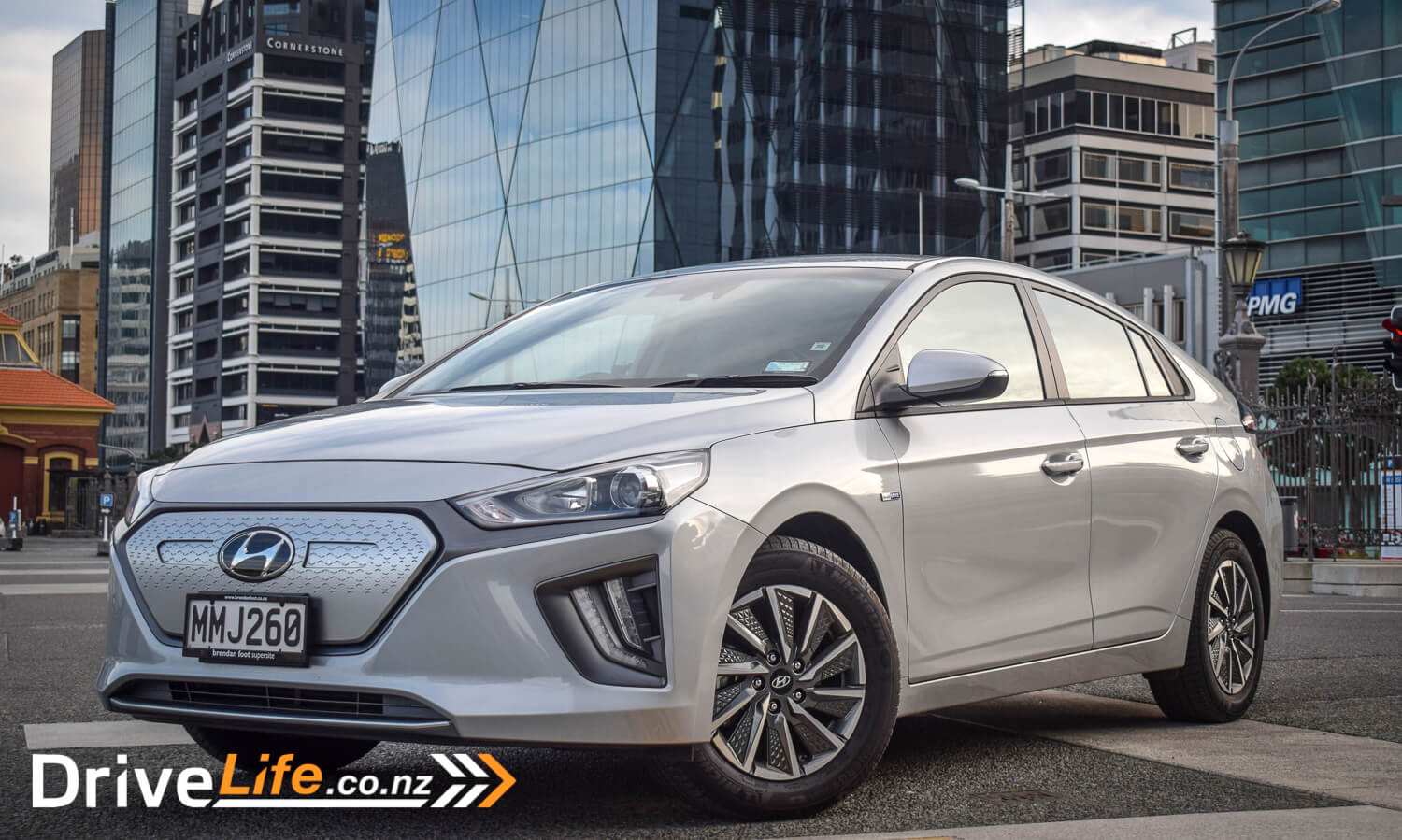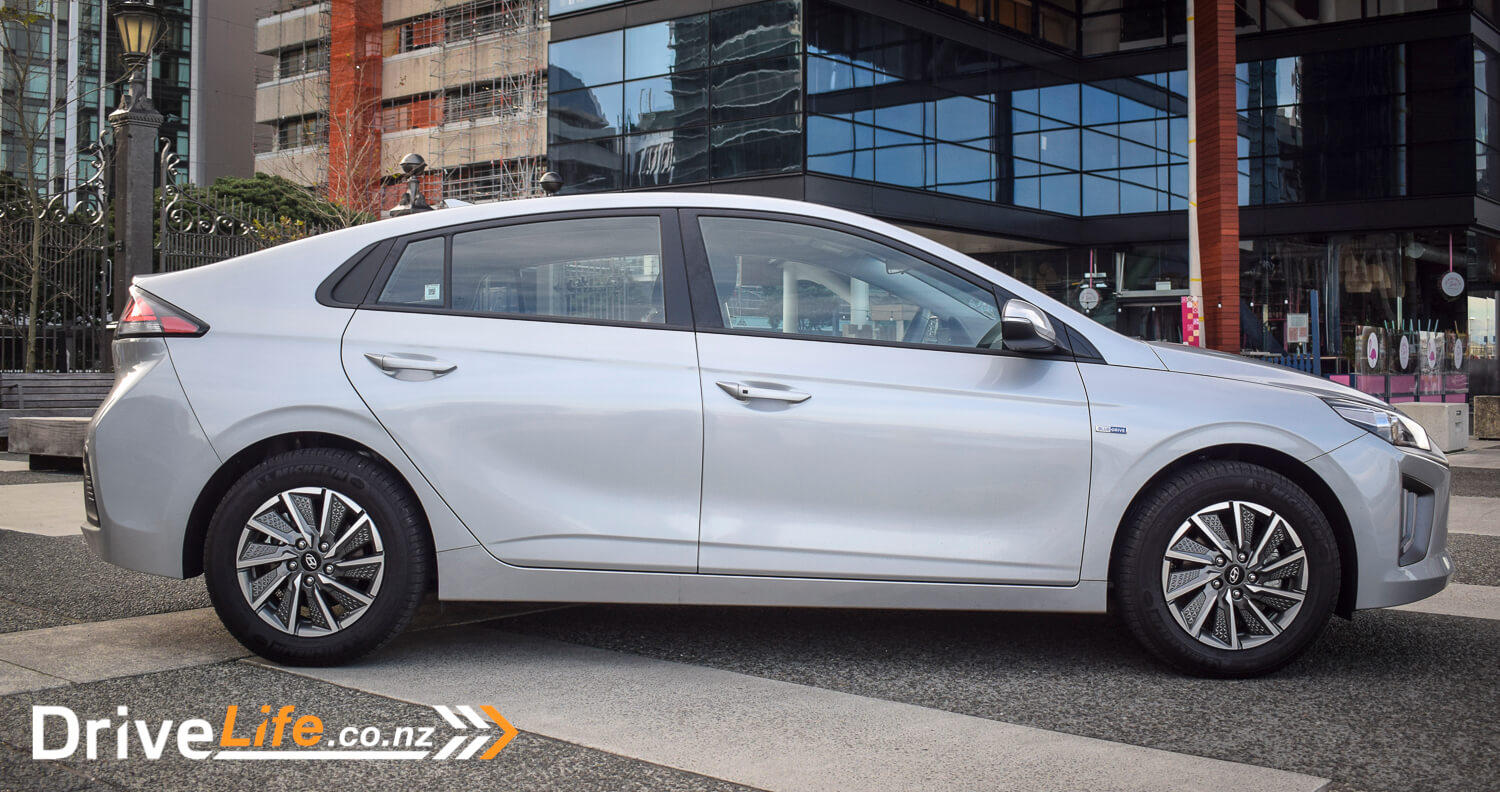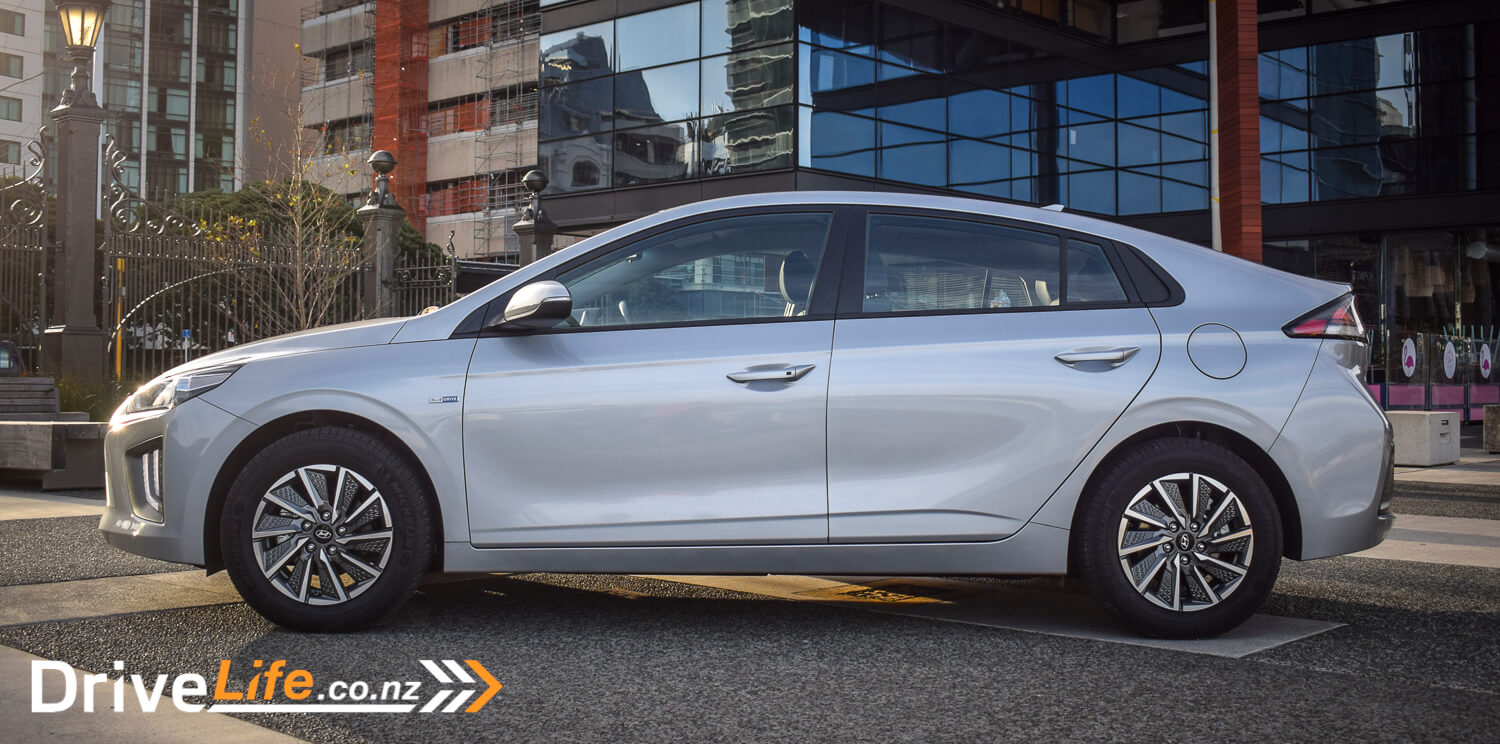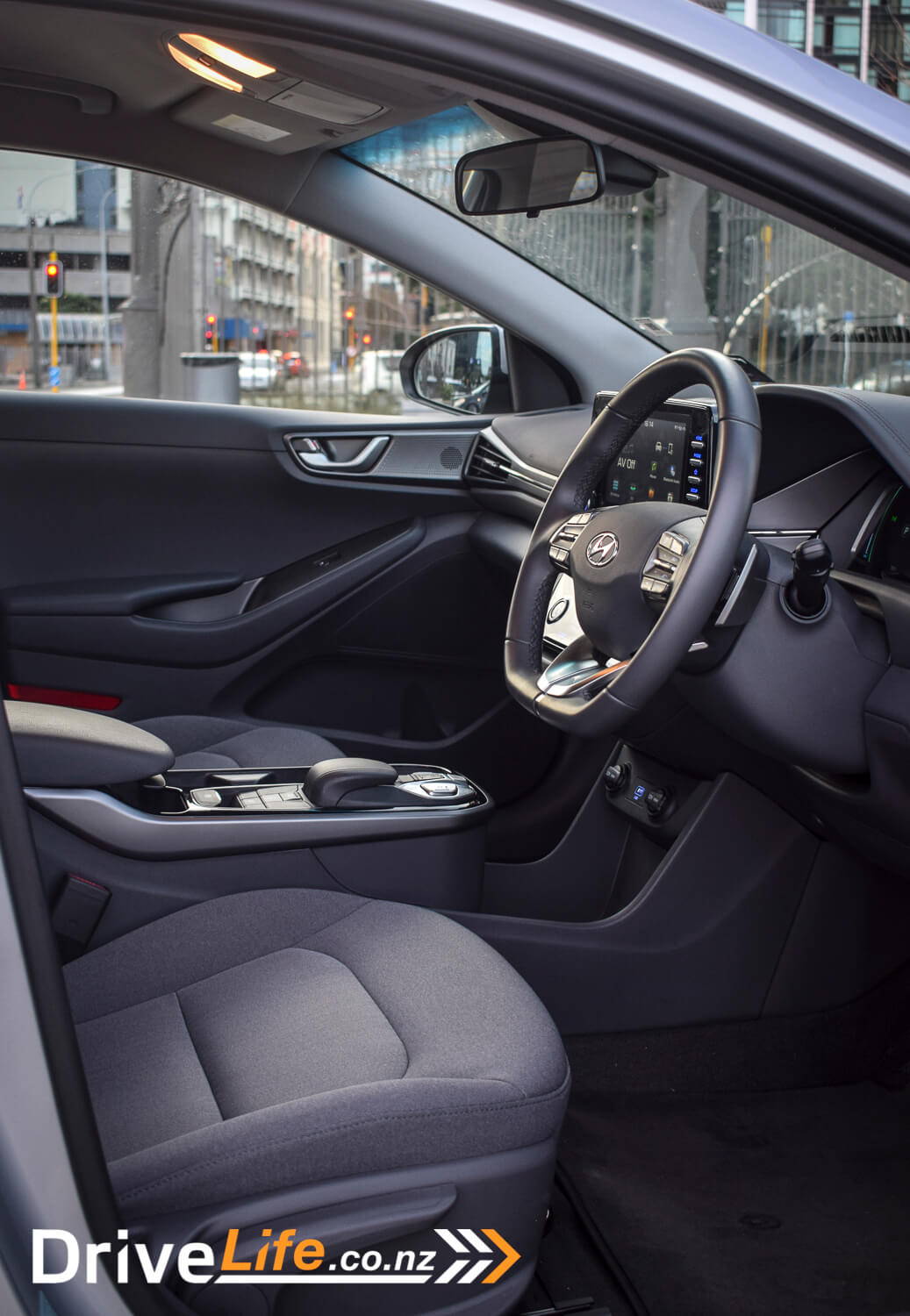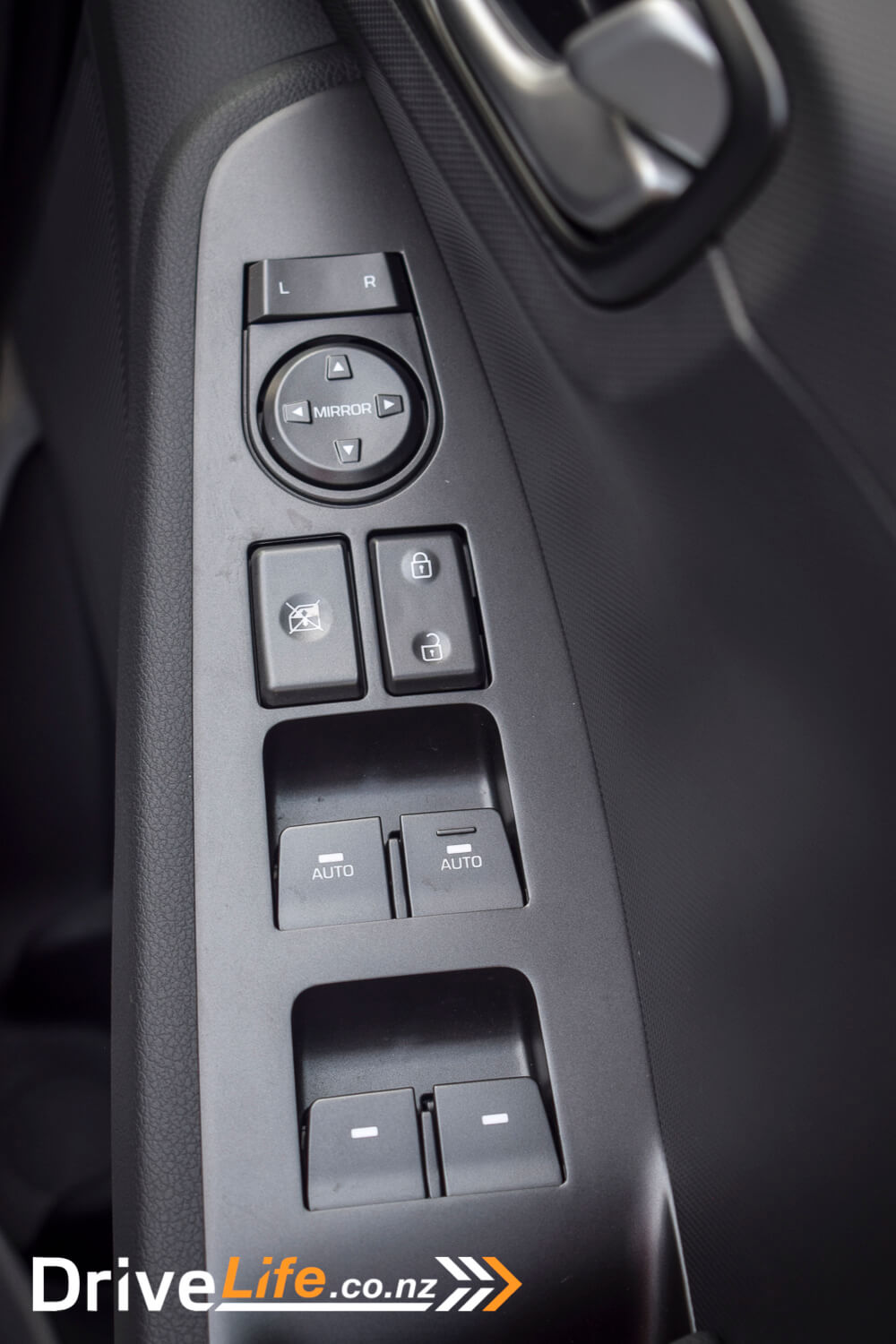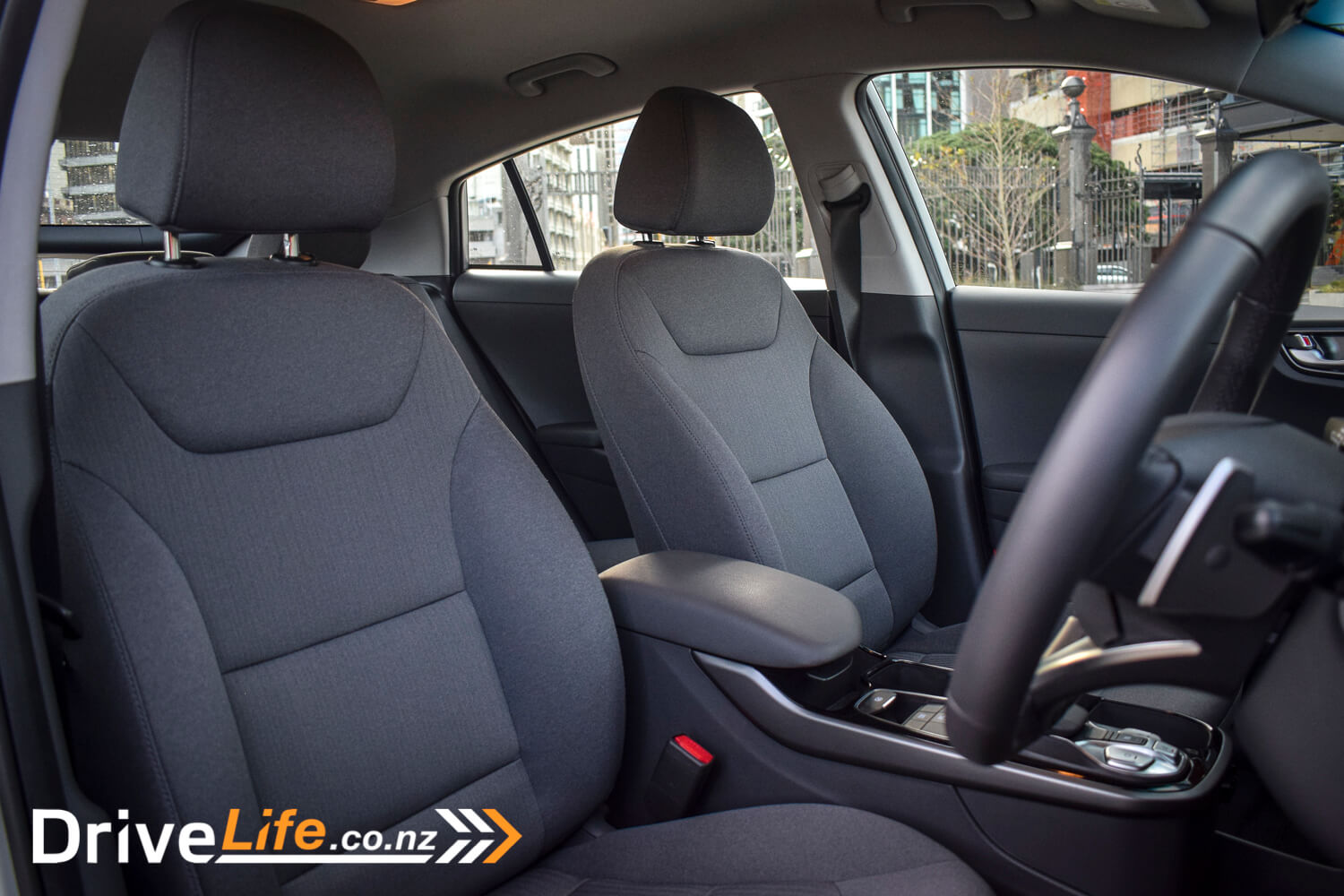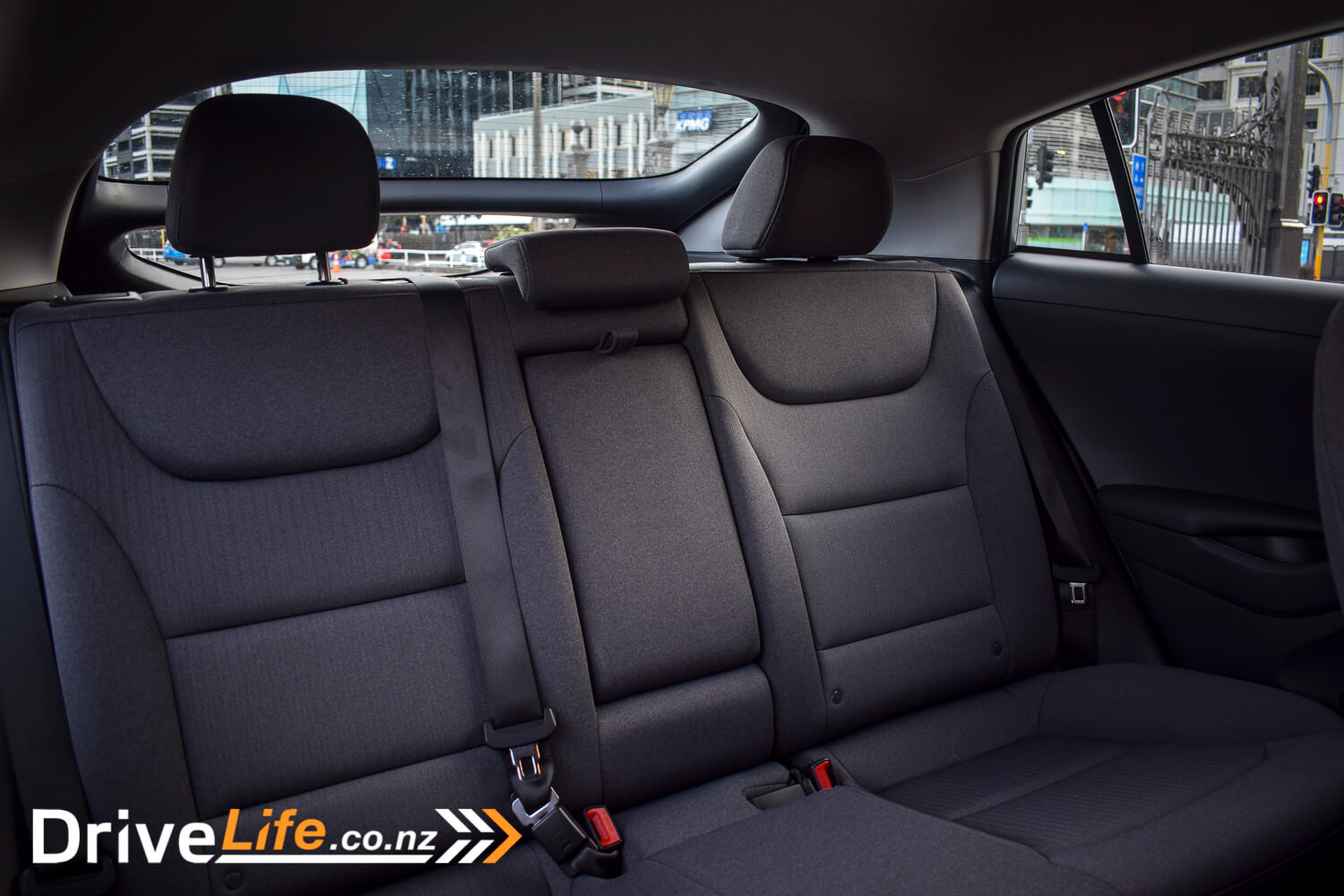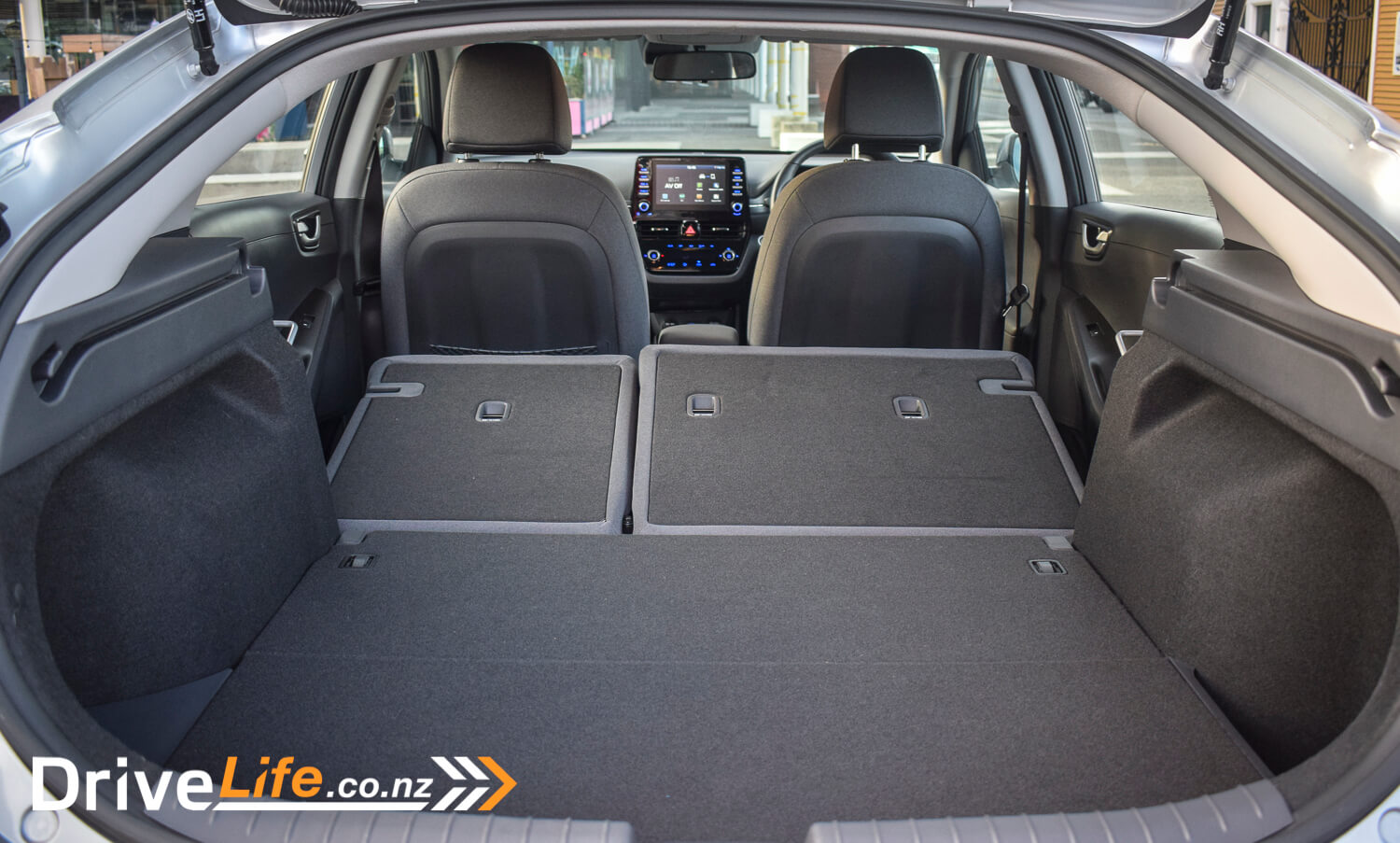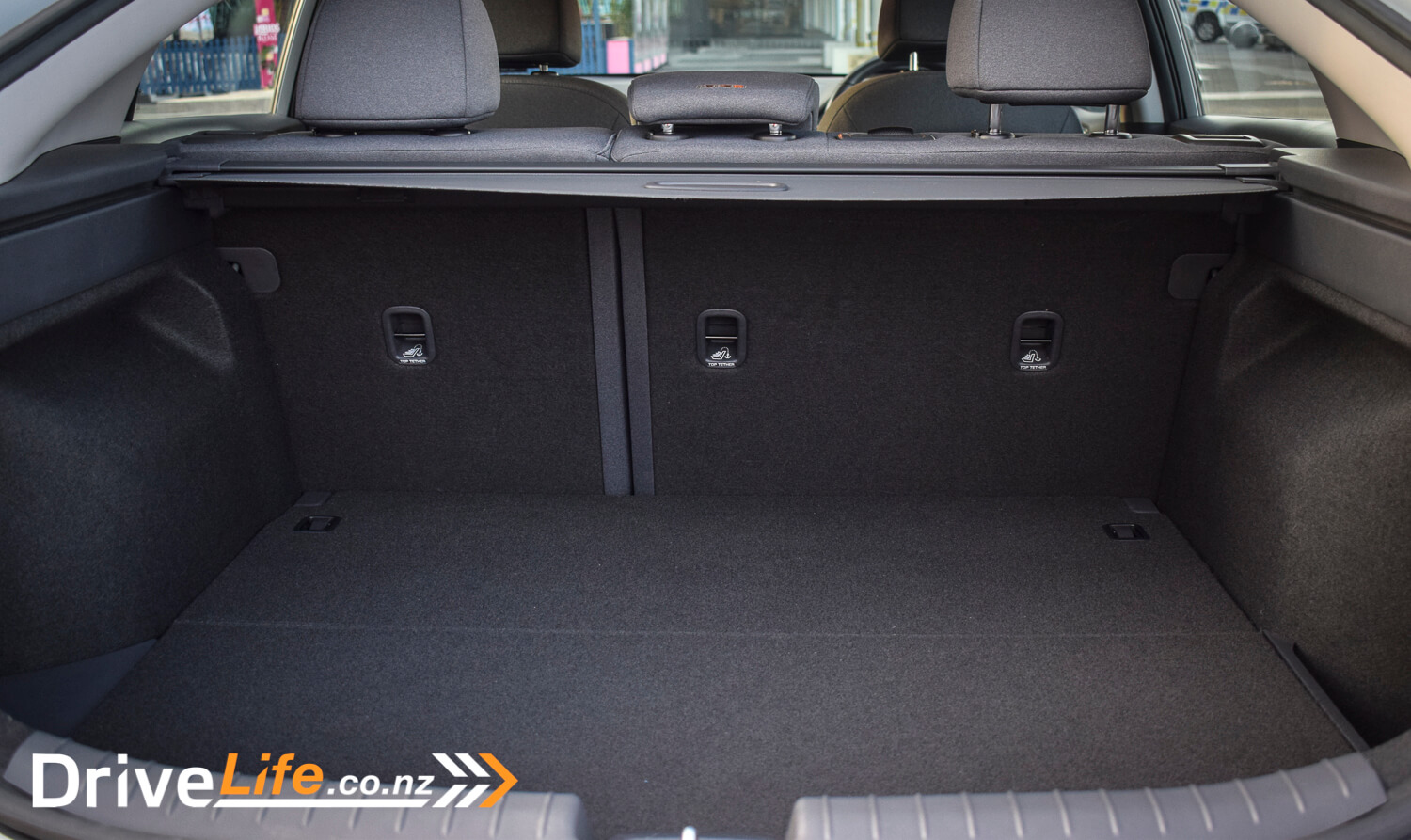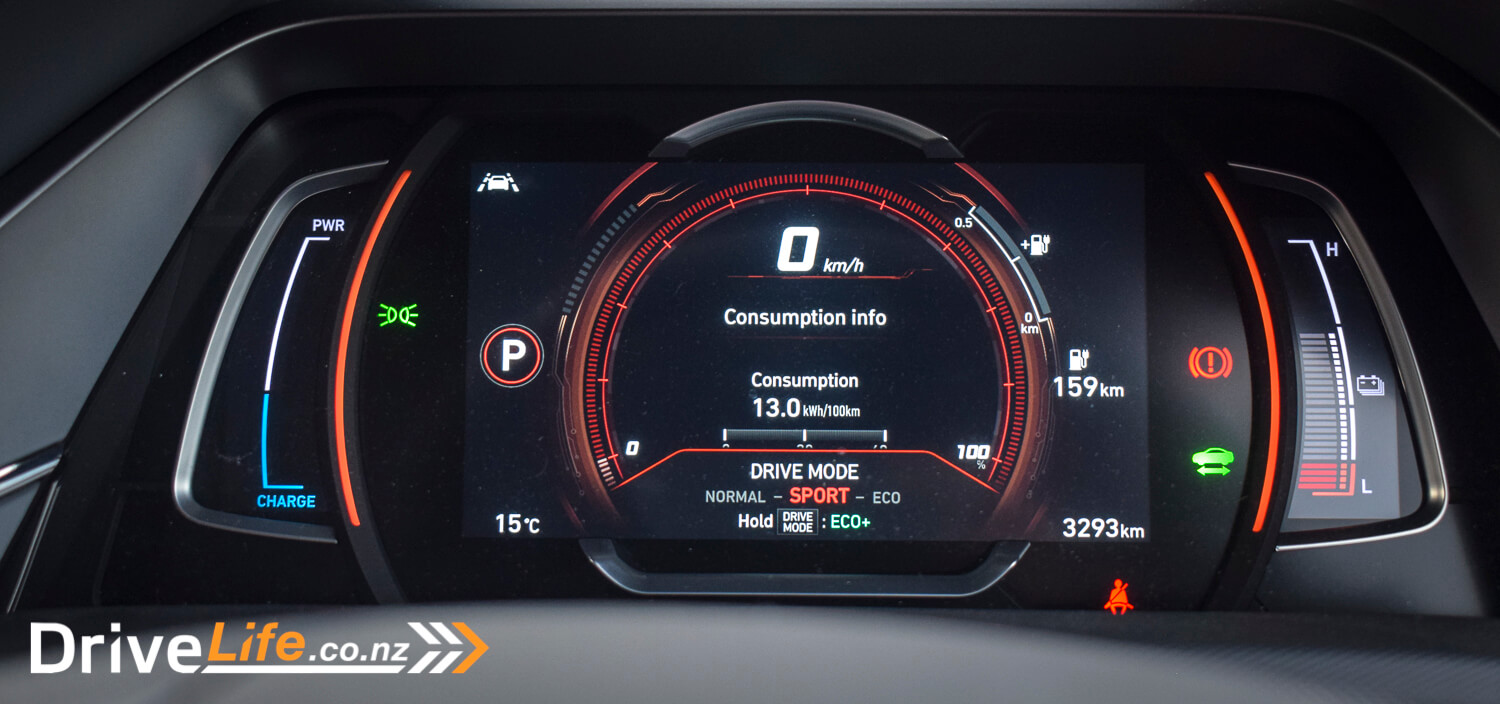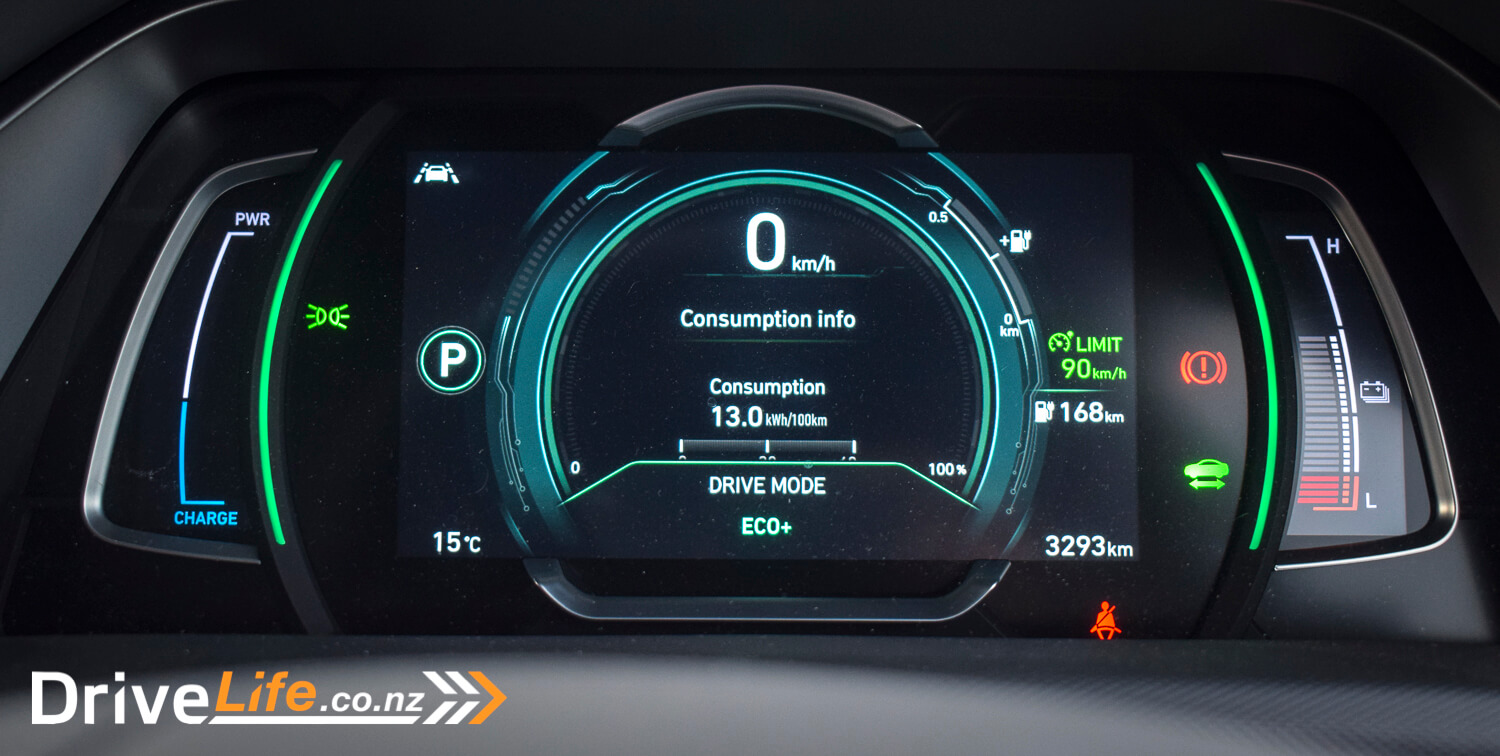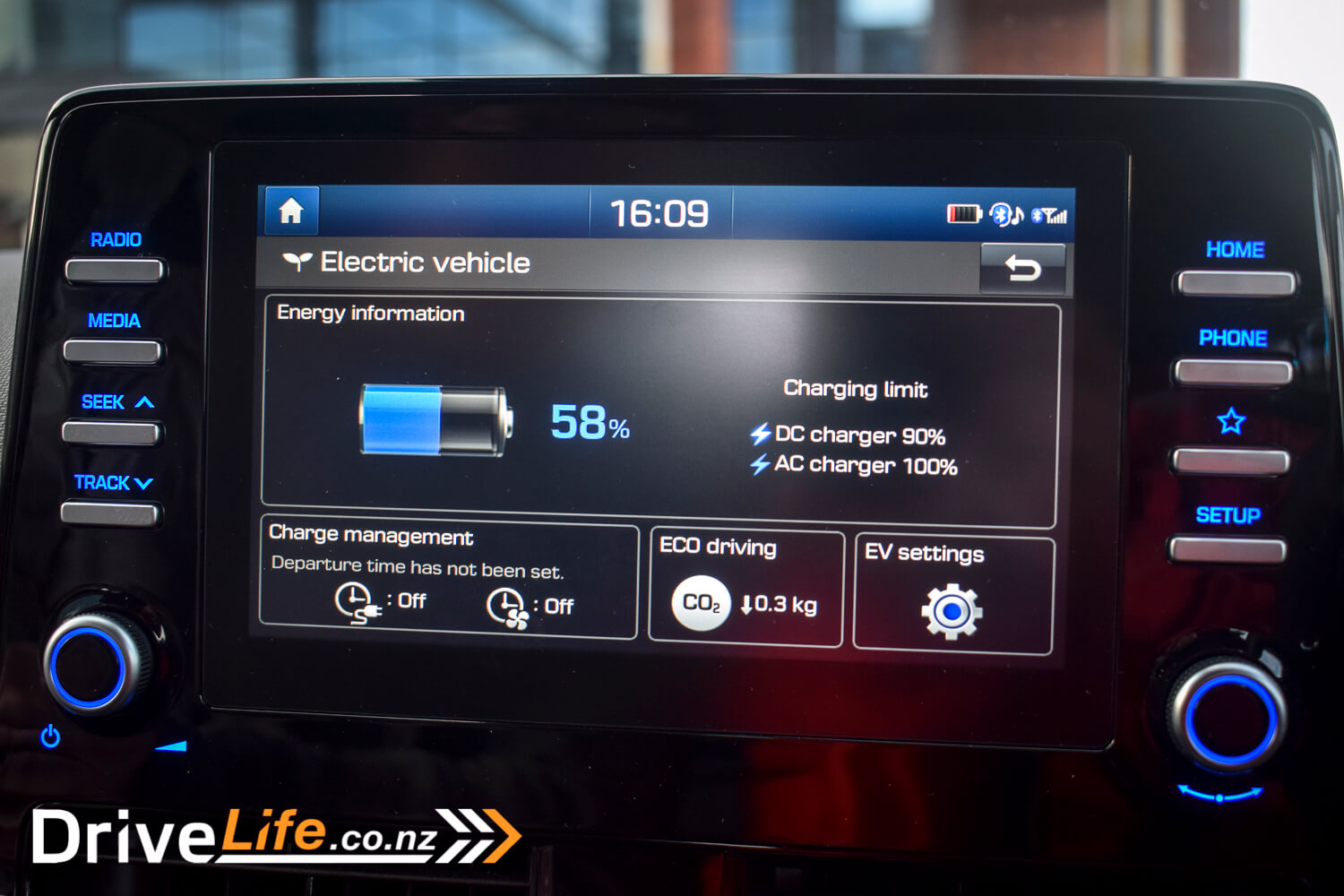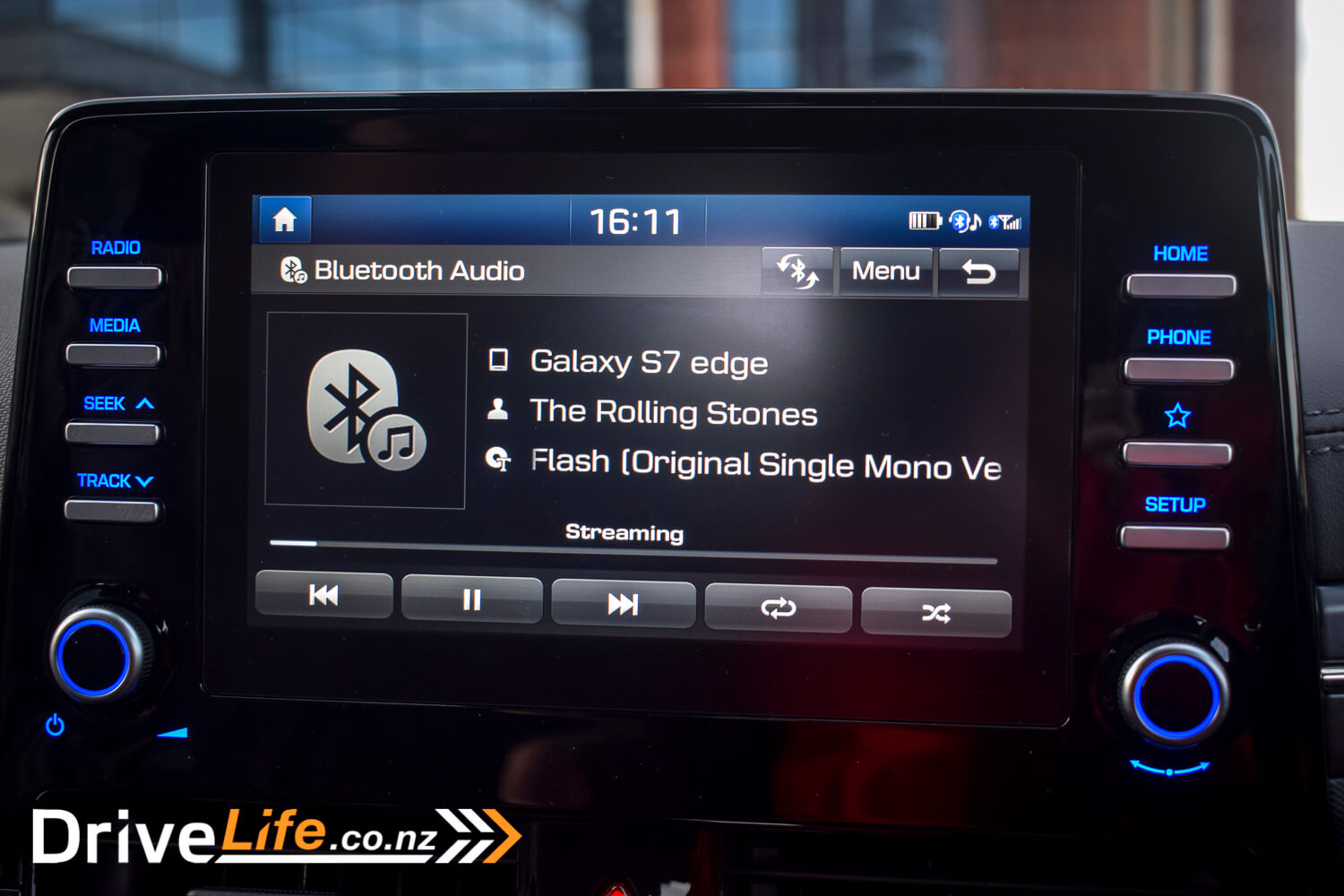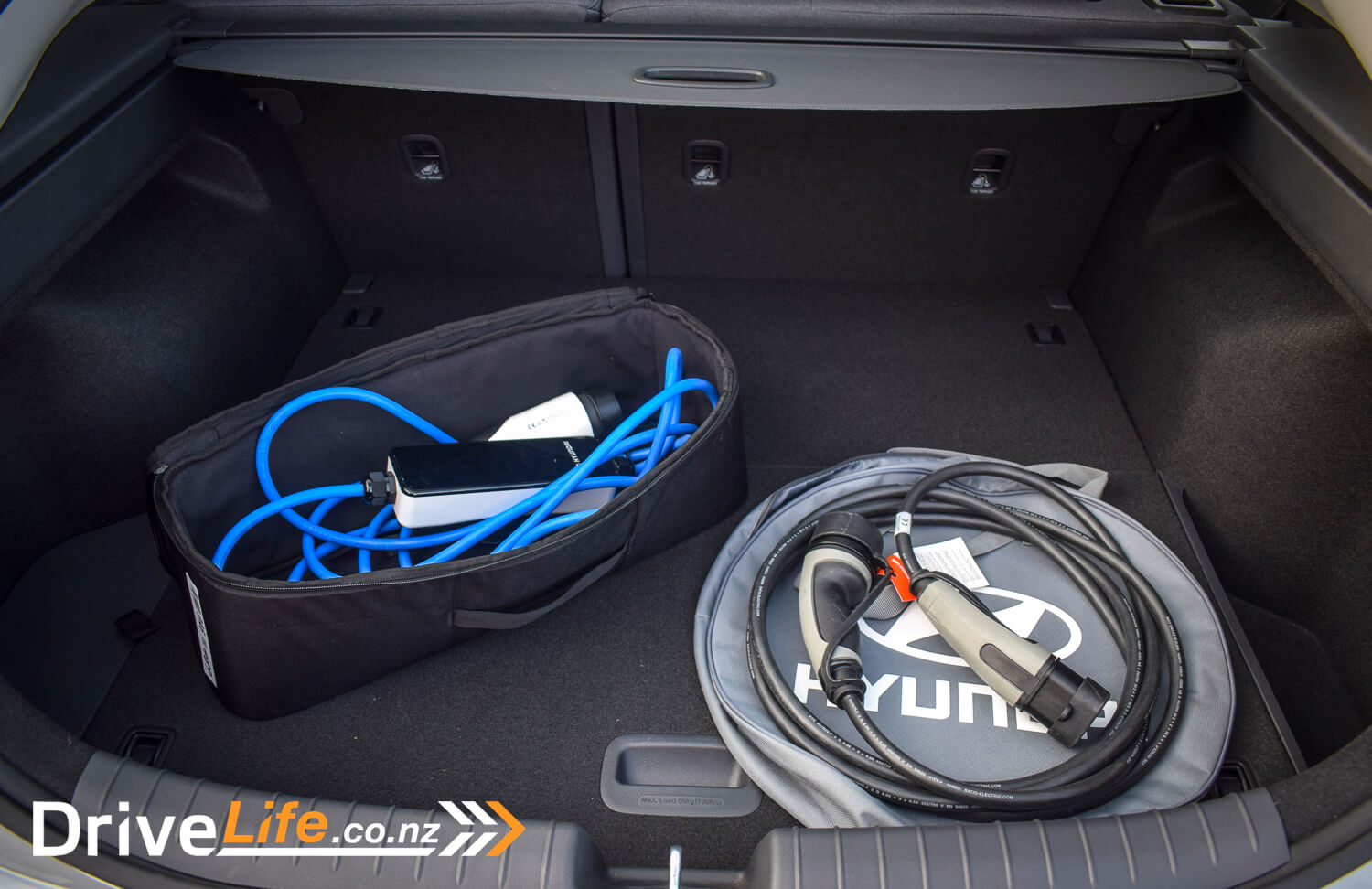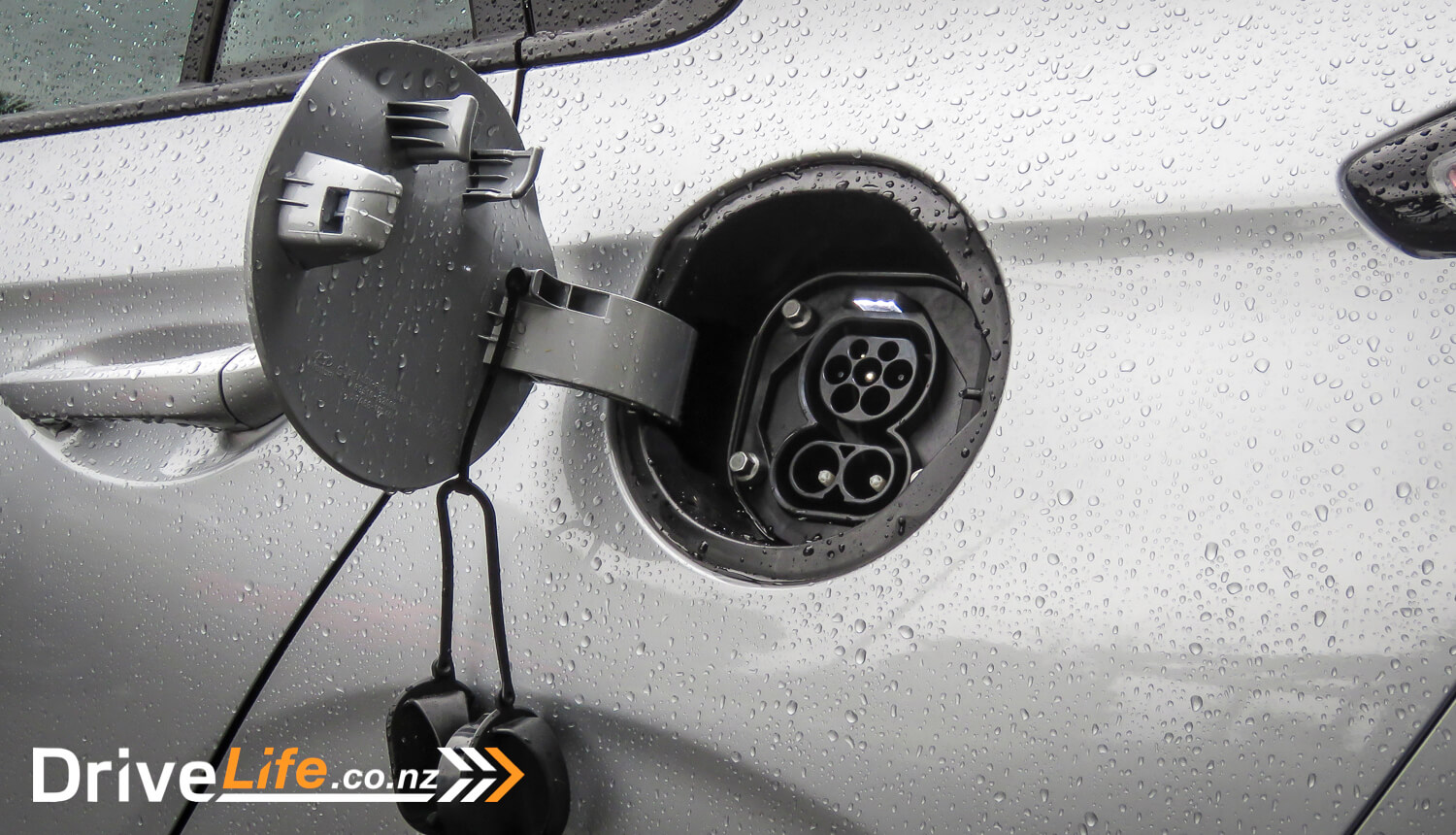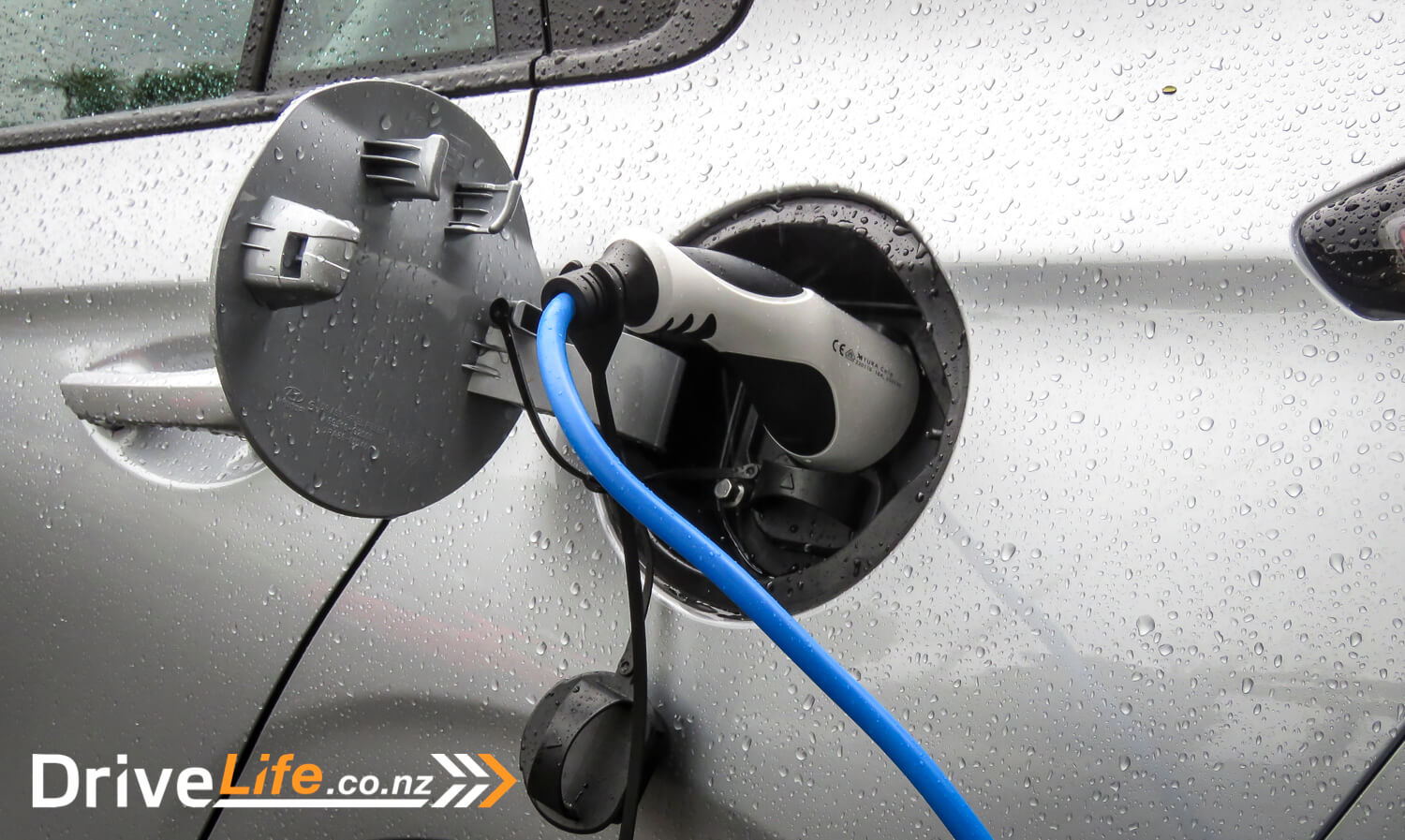Regular readers are likely aware that all of DriveLife’s writers are devout petrol-heads, and I am no exception. When electric cars first began to arrive in popular format, I was sceptical of their ability to compete with the mighty internal combustion engine. But the benefits of electric vehicles cannot be denied; instant torque, reduced running emissions, and efficient use of stored energy are few examples among many. Ever since seeing the 2000hp Lotus Evija Electric Vehicle at the 2019 Monterey Car Week, I’ve certainly become a lot more intrigued by pure EVs and electric drivetrains.
Since arriving in 2017, the Hyundai Ioniq EV has entered as an attainable and realistic view of what the future vehicle landscape could look like. I was certainly interested to have a go in the new 2020 Ioniq EV.
This is my first time living with an EV – so what did I think of Hyundai’s self-proclaimed eco game-changer?
What’s In The 2020 Hyundai Ioniq EV Series II Range?
Hyundai’s Ioniq is offered in three different variants in New Zealand; the Hybrid, the Plug-In Hybrid Electric Vehicle (PHEV), or the Electric Vehicle (EV).
The 2020 Ioniq EV is the second series of the Ioniq EV, since first being released in 2017. The new Ioniq EV, aptly named the Ioniq Series II, offers a raft of new features including refreshed styling, upgraded standard equipment and a new battery and motor combination. The new, larger 38.3kWh battery gives the Series II Ioniq EV a claimed driving range of 311km on a charge, an increase of 33% from its predecessor which only offered 204km from a 28kWh battery.
For any of the Hyundai Ioniq’s models, you can buy an entry-level model, or upgrade to the Elite. The body is the same across each of the drivetrain variants, with subtle exterior differences to visually distinguish each model. Our entry level vehicle costs $65,990, while the Elite is offered at $71,990 for the EV drivetrains.
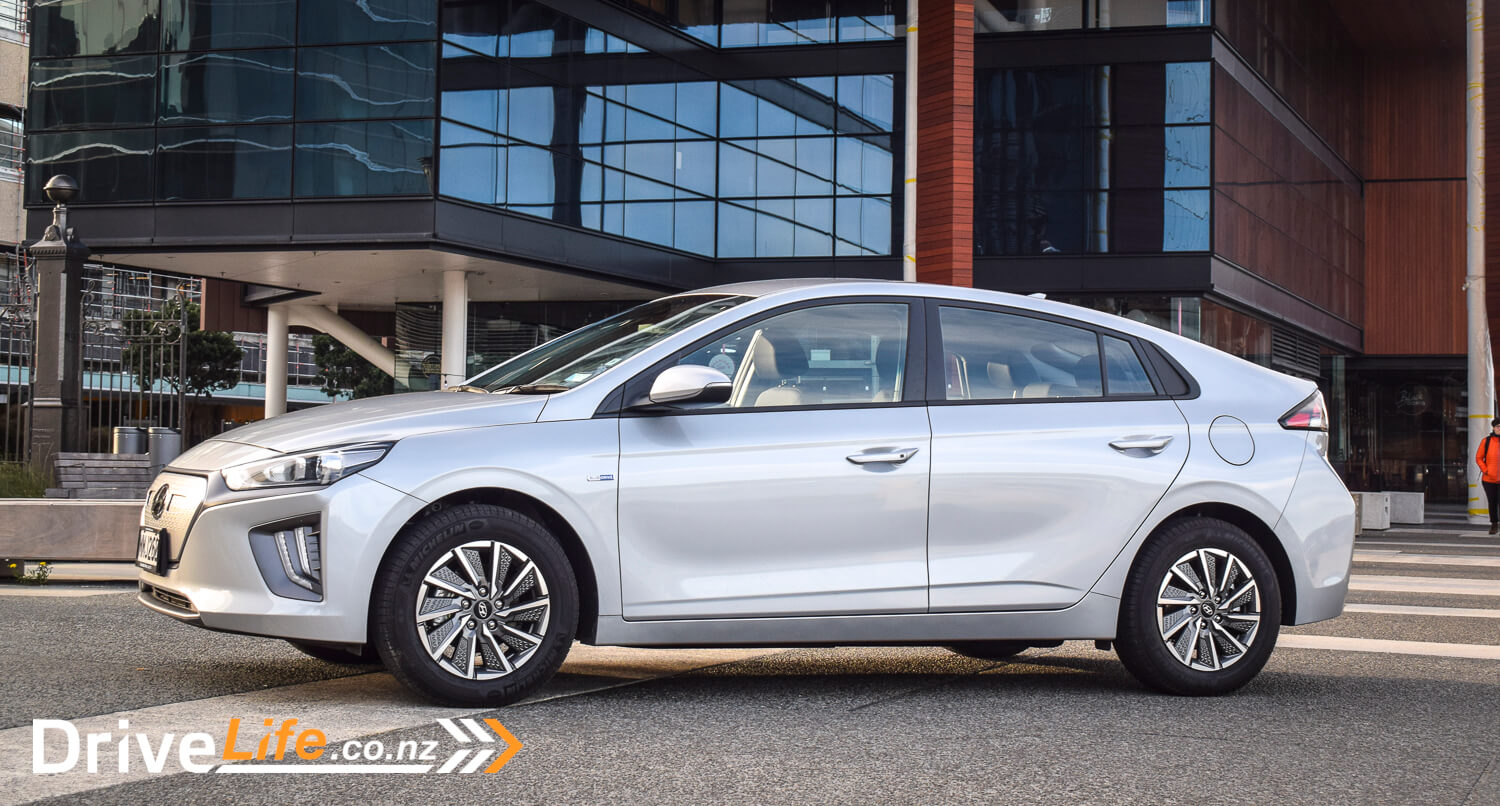
Standard specifications are largely consistent across each variant. Key differences for the entry-level EV include a 7” Thin-Film-Transistor LCD instrument cluster display, auto defog, rain sensor, folding electric mirrors, LED rear-lights and single-zone climate control.
Drivelife’s Fred Alvrez reviewed the 2020 Hyundai Ioniq PHEV in June. You can check out the review and the list of specs here.
There’s a range of colours available, including Polar White, Intense Blue, Typhoon Silver, Iron Grey, Fiery Red and Phantom Black. Our test vehicle came in Typhoon Silver.
You can read more about the Hyundai Ioniq range on Hyundai New Zealand’s website.
First Impressions Of The 2020 Hyundai Ioniq EV Series II
The Ioniq is perhaps one of the more modest choices amongst the competition of Hybrid, EV and other alternative fuelled vehicles. The design is rather inoffensive and there’s nothing particularly striking about it. The body lines are clean and modern, while the long Kammback style roof-line connecting to the flat-rear end resembles the typical shape associated with an alternative-fuelled vehicle. It’s a similar style to the shape of a second-generation Toyota Prius, but better looking.
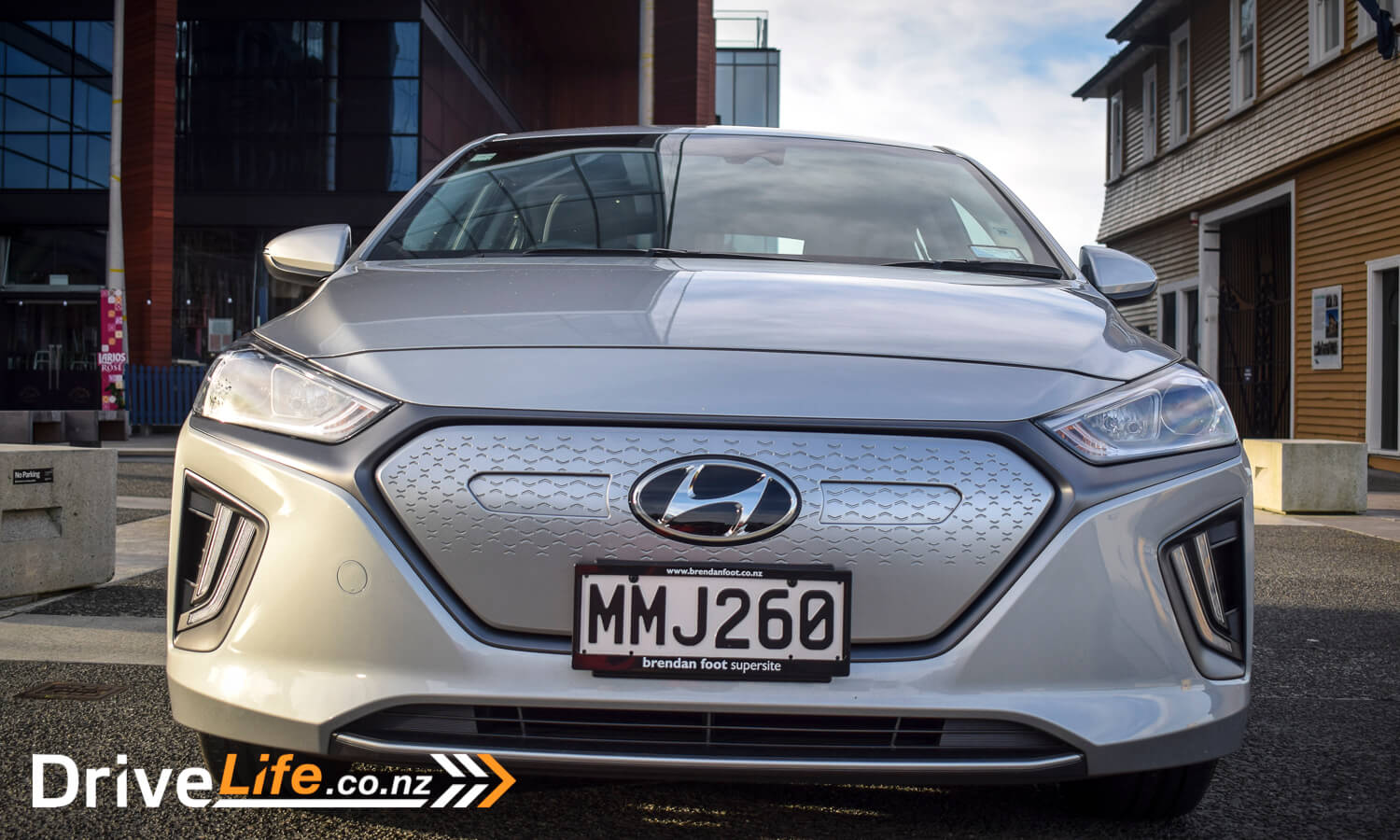
The keen-eyed will notice subtle changes from Ioniq’s PHEV and Hybrid variants, with the EV distinguished by sharp LED rear lights, different alloys and a flat textured shield instead of a grille (generally EVs don’t have a ‘grille’ per se). The badge which says “electric” on the back should also be a give-away.
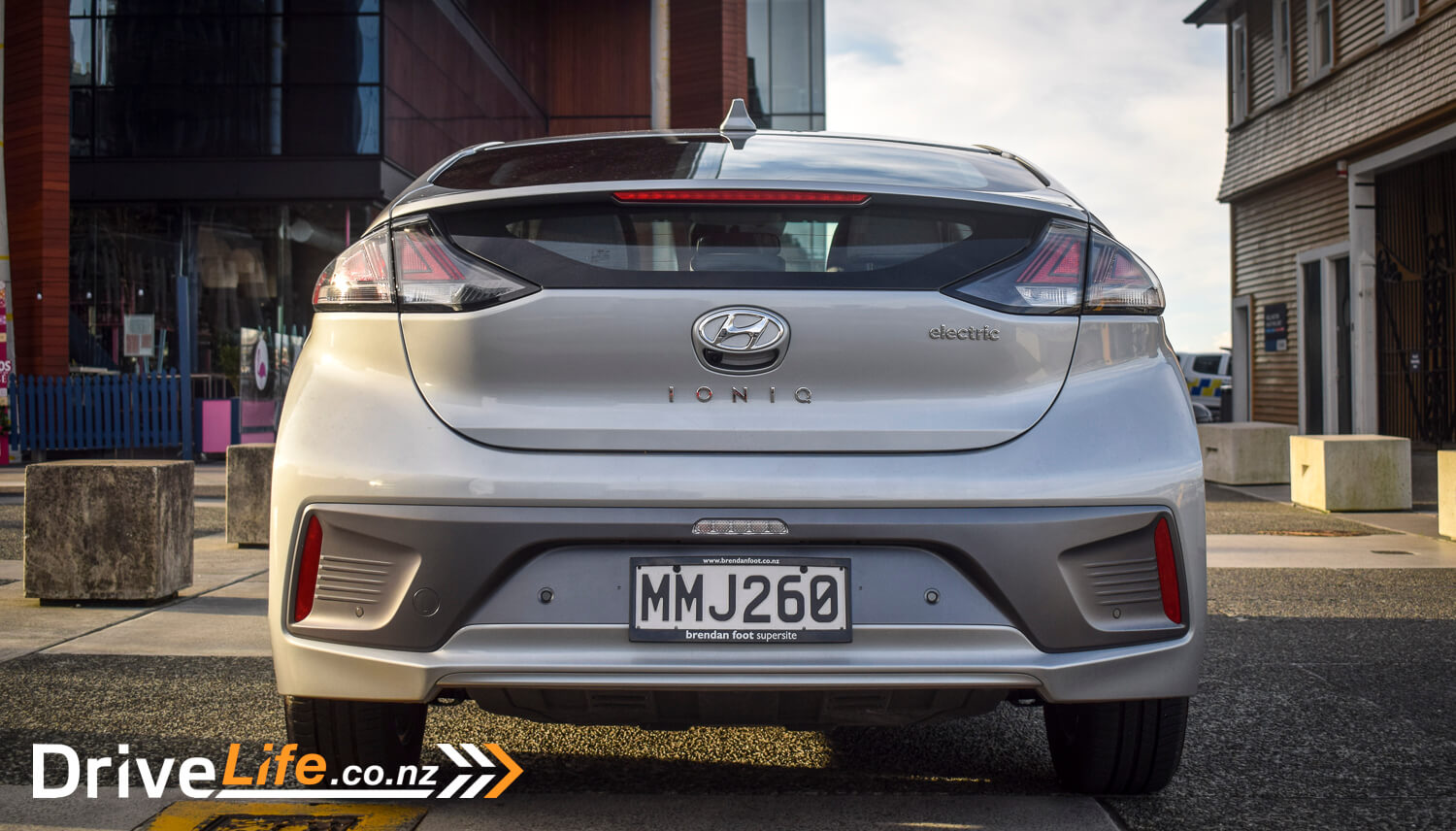
The 2020 Ioniq EV also has minor facelifts from the previous generation. The updated front-end on the Ioniq EV is better than its predecessor, which had tried to compromise for the lack of a grille with a different colour, curved panel in place of a shield (or grille). It looked okay, but kind of looked like the old car was wearing a face mask. The updated daytime running light design is better too.
Overall, the updated styling on the Ioniq EV is more modern and sharper than its predecessor, and personally, I prefer the look of the Ioniq EV over its Hybrid and PHEV variants.
What’s The Interior Like On A 2020 Hyundai Ioniq EV Series II?
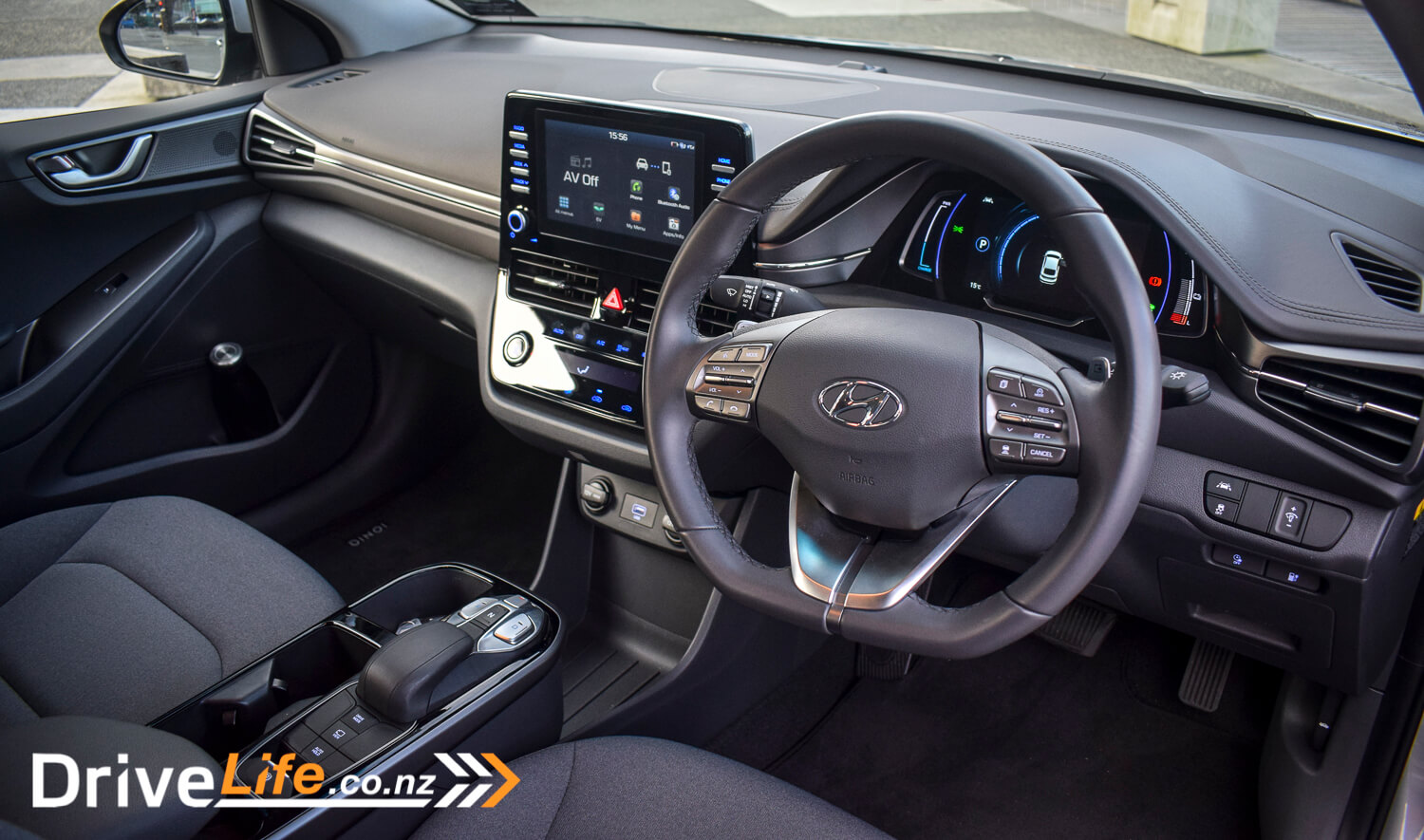
Stepping inside the Ioniq EV, my first observation of the interior is just how spacious it feels. There’s a lovely openness about the cabin, which I suspect is strongly helped by the driver’s outward visibility. From inside the Ioniq, the driver’s visibility is fantastic. It’s possibly one of the best modern vehicles I’ve come across. This fact alone left me unbothered that the entry-level vehicle does not come with blind-spot monitoring, nor was I bothered by the partitioned rear window.
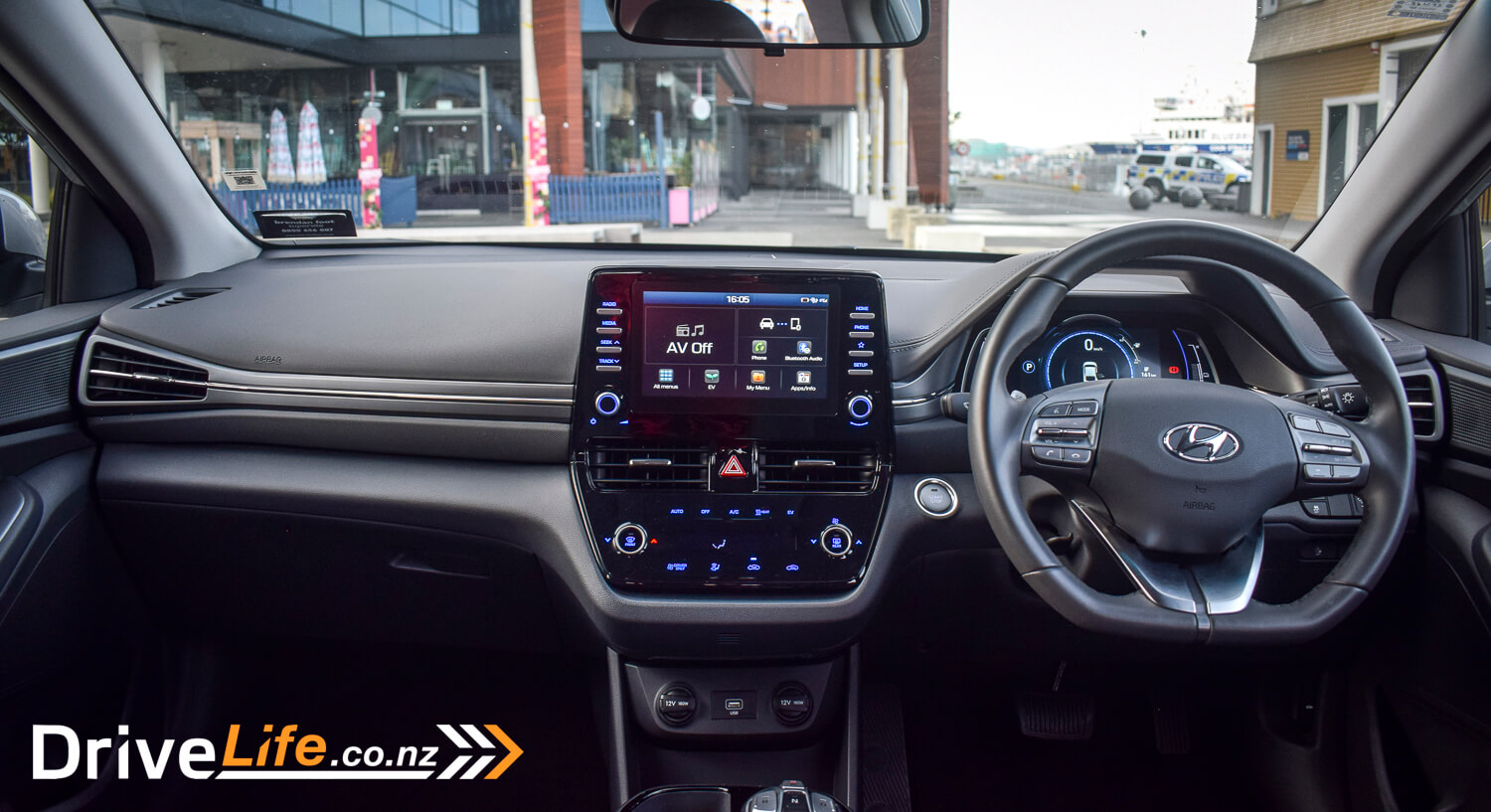
Focusing on the inside, the Ioniq’s interior does appear slightly ‘no-frills’ with its abundant use of grey materials and hard plastics on the inside. However, many of the surfaces are topped with soft touch materials and feel nicer than they look.
The Ioniq’s interior also felt sturdy and well-assembled. Even with all the plastics, nothing felt too flimsy. It seemed like most trim pieces could handle prolonged wear and tear, which is important for an EV given that there’s no engine to cover-up interior rattles or noises.
The seats are upholstered in a grey fabric with a subtle striped pattern. Again, not particularly exciting to look at, but they were comfortable and had adequate back and under-thigh support. Rear passenger leg-room was also good, plus the head-room was decent too.
The carpet and roof-lining are made from sugar-cane derived products, which definitely enhances the green credentials of the vehicle.
Sitting in the driver’s seat, you are greeted with a 7’’ high-resolution TFT LCD digital dash cluster. This dash is definitely a strong point of the Ioniq’s interior. It displays information clearly and logically and has noticeably better resolution than the centre infotainment screen. You can also customise various vehicle features, including the auto-locks, convenience lights and the driver-aid features.
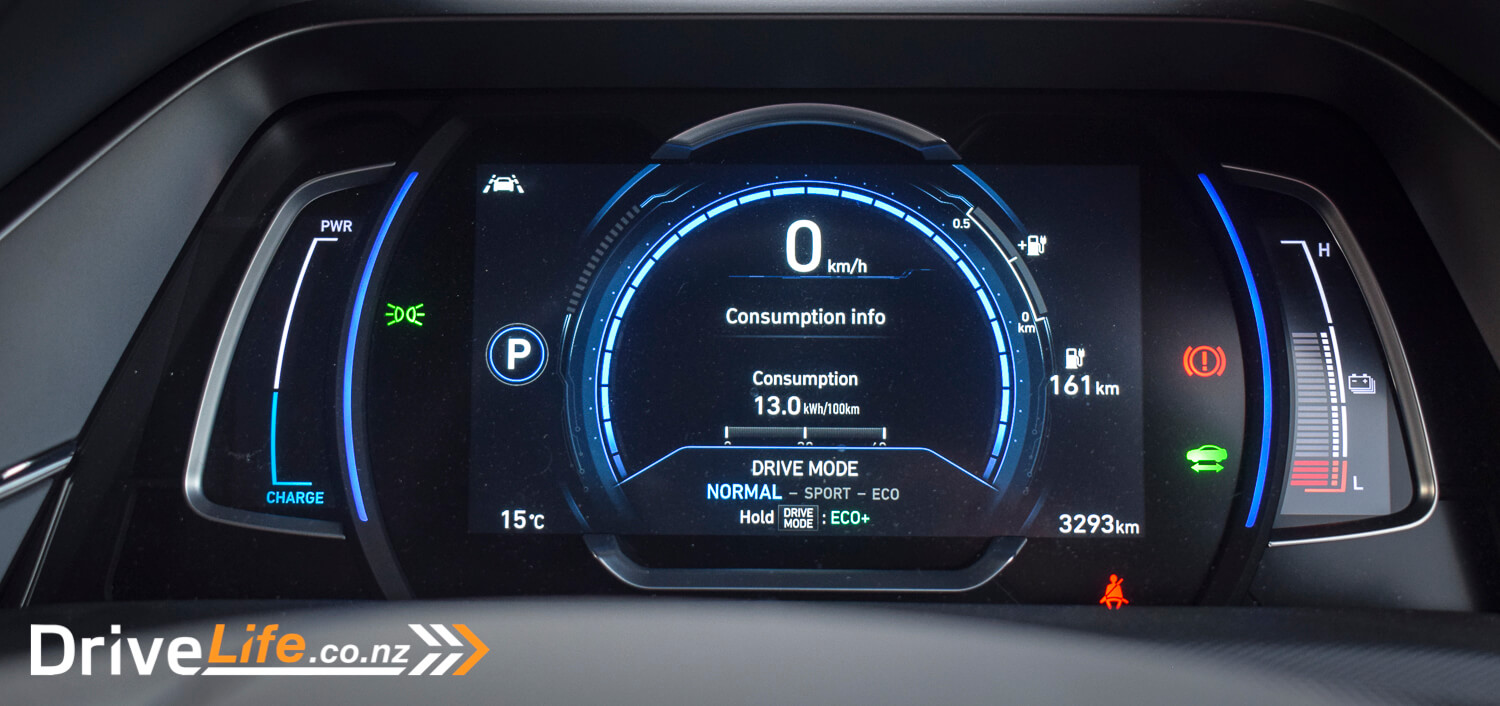
The 8’’ centre infotainment works well, despite being slightly laggy between some menus. The infotainment graphics are average, especially when compared to the crisp graphics of the drivers display. There’s no navigation, instead the car relies on phone mirroring using either Android Auto or Apple Carplay. There’s a slight oddity when playing music through Bluetooth in the Ioniq – the screen will constantly tell you that the car is “streaming”, accompanied with a never-ending loading bar. I don’t really understand why Hyundai felt the need to put that in.
Hyundai has also gone the route of using capacitive touch controls for the climate controls in the Ioniq. Personally, I am not a huge fan of capacitive touch controls. They often look nice, but they tend to be either far too sensitive or too slow to respond, and will generally get very fingerprint stained in the process. However, to Hyundai’s credit, they’ve managed to make the controls look good and function quite consistently. Although, on some occasions, I did happen to unintentionally interact with some controls while my hand was near to them. Hyundai also hasn’t quite solved the fingerprint issue.
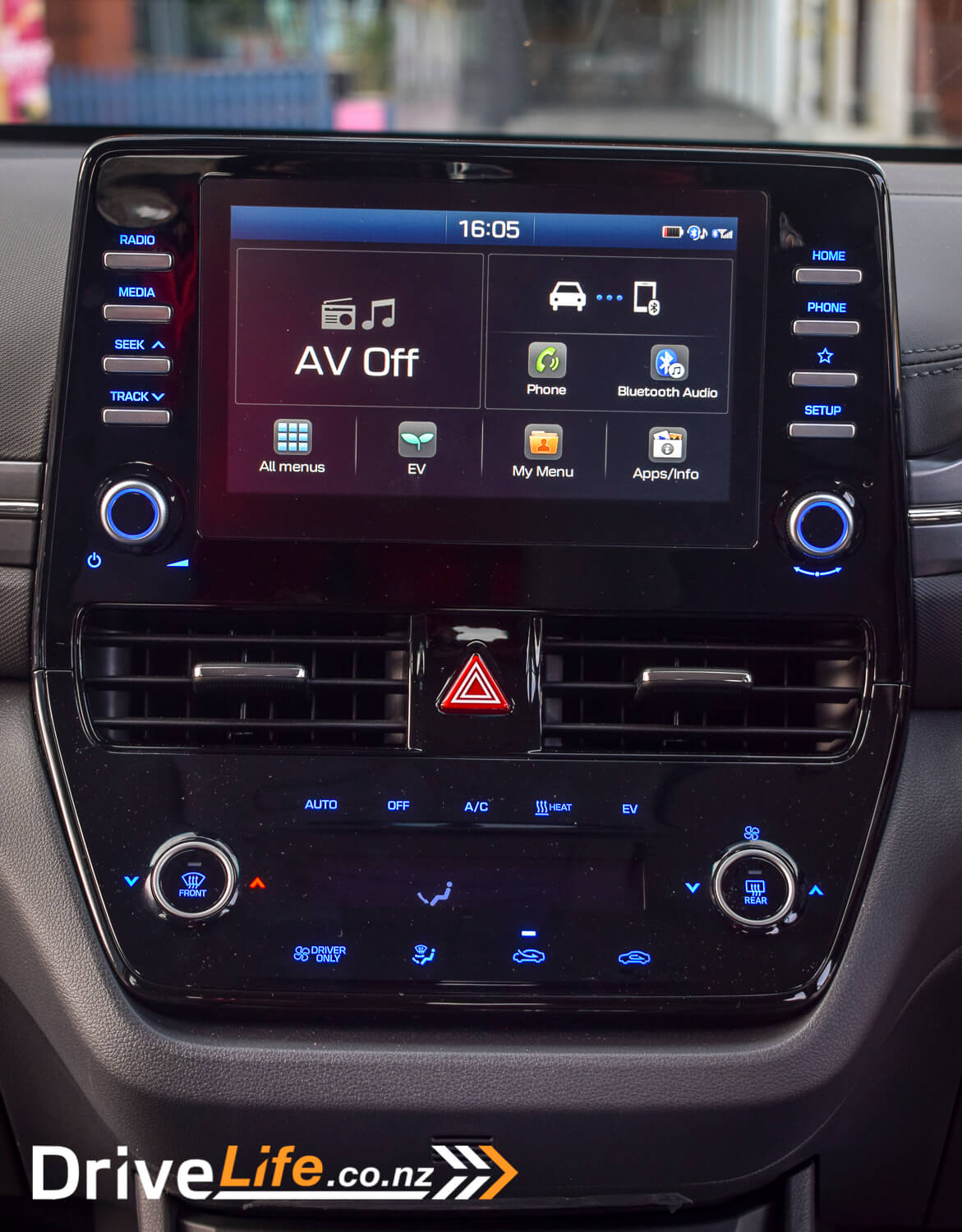
My main gripe with the Ioniq’s interior is the centre console design. It looks fine in pictures, yet in reality, the storage is quite awkwardly laid out. The main issue I had was that I could not find an obvious place to store my smartphone securely.
The front storage hole wouldn’t work, despite this being the location for the optional wireless charger on the Elite model. The other storage hole is an odd shape and also partially obscured by the centre console lid. I could only just fit the phone in there diagonally. It certainly felt like there weren’t any natural places to store it, so I opted to place my phone between the cupholders instead. These cupholders were an okay size, but slightly on the shallow side. Meanwhile, the centre storage bin is deep. You could nearly get a bowling ball in there if it was a bit wider.
The centre console storage does seem like an odd thing to complain about, but for a car that relies on Android Auto or Apple Car Play for Navigation and other features, it’s a bit of a pain. Especially because the logical place to plug in to operate either of these programs is using the front USB port under the climate controls.
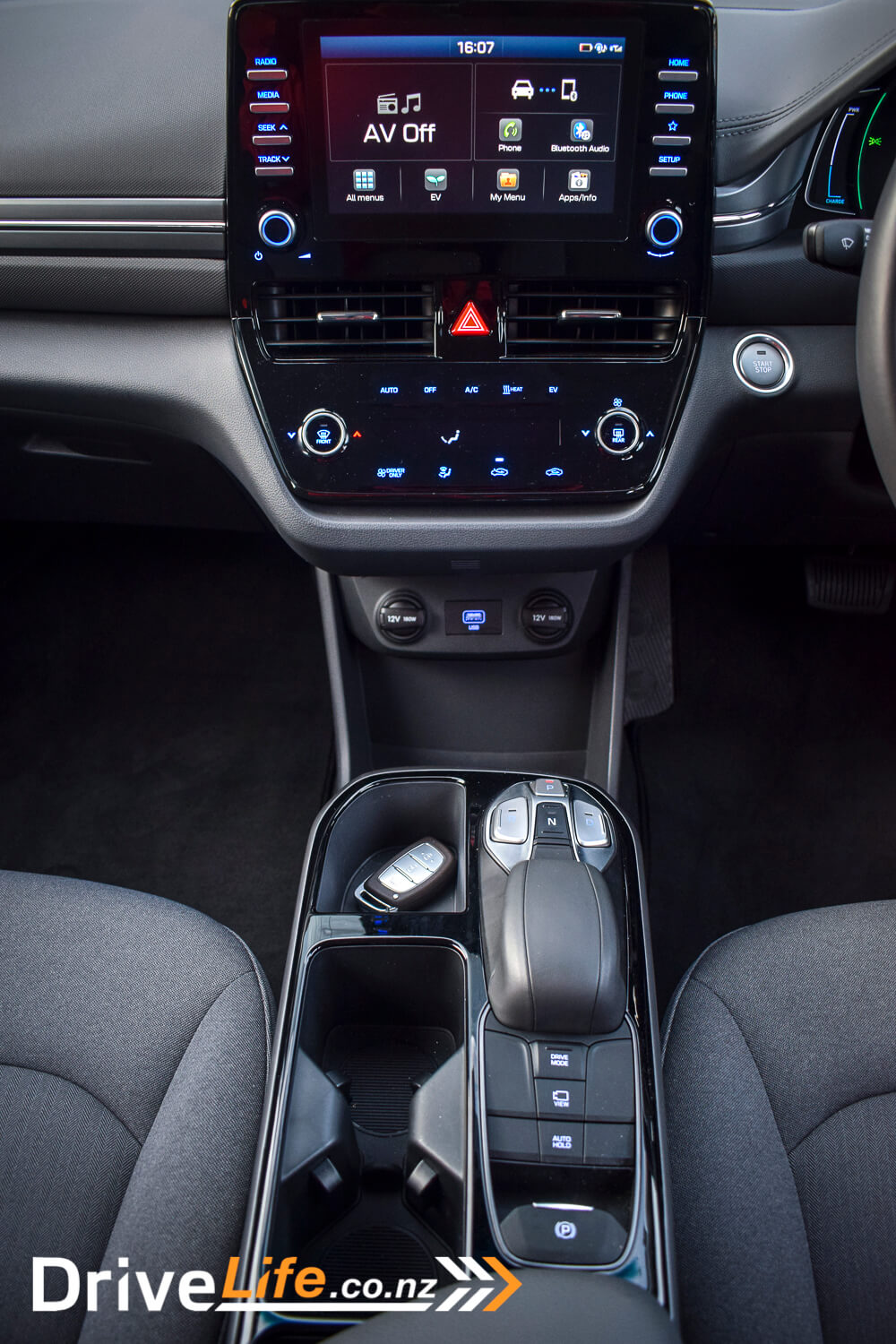
The arrangement of the console in the PHEV and Hybrid models appears better optimised, even though there’s less space to work within these vehicles due to the transmission tunnel. The awkward layout in the EV just seems like a missed opportunity. However, I will give credit to Hyundai for making the drive-selector buttons look rather cool.
Another interior quirk of the Ioniq which amused me was the button to open the charger port cover looks like a fuel pump, only with a plug attached to the end. There was definitely no second-guessing what it was. I also appreciated that the charging ports had an internal courtesy light, which came in handy when charging the car at night.
I may have sounded a bit tough on the Ioniq thus far. In reality, there is nothing unpleasant about the interior. It’s perfectly functional, well-equipped and comfortable for the day-to-day. However, you wouldn’t be blamed for feeling that the interior isn’t becoming of a vehicle with a mid-60 grand price tag. Anybody who has seen the inside of a Kia Stinger will know that Hyundai/Kia can make a functional and great-looking interior. It seems like Hyundai could have benefited from poaching some of their designers from their subsidiary for the Ioniq.
I will concede that EVs are expensive to produce and that everything has a compromise. Instead, the Ioniq focuses its efforts on the technological and driving aspects of the vehicle. All things considered; I believe Hyundai has done quite well with the Ioniq’s interior.
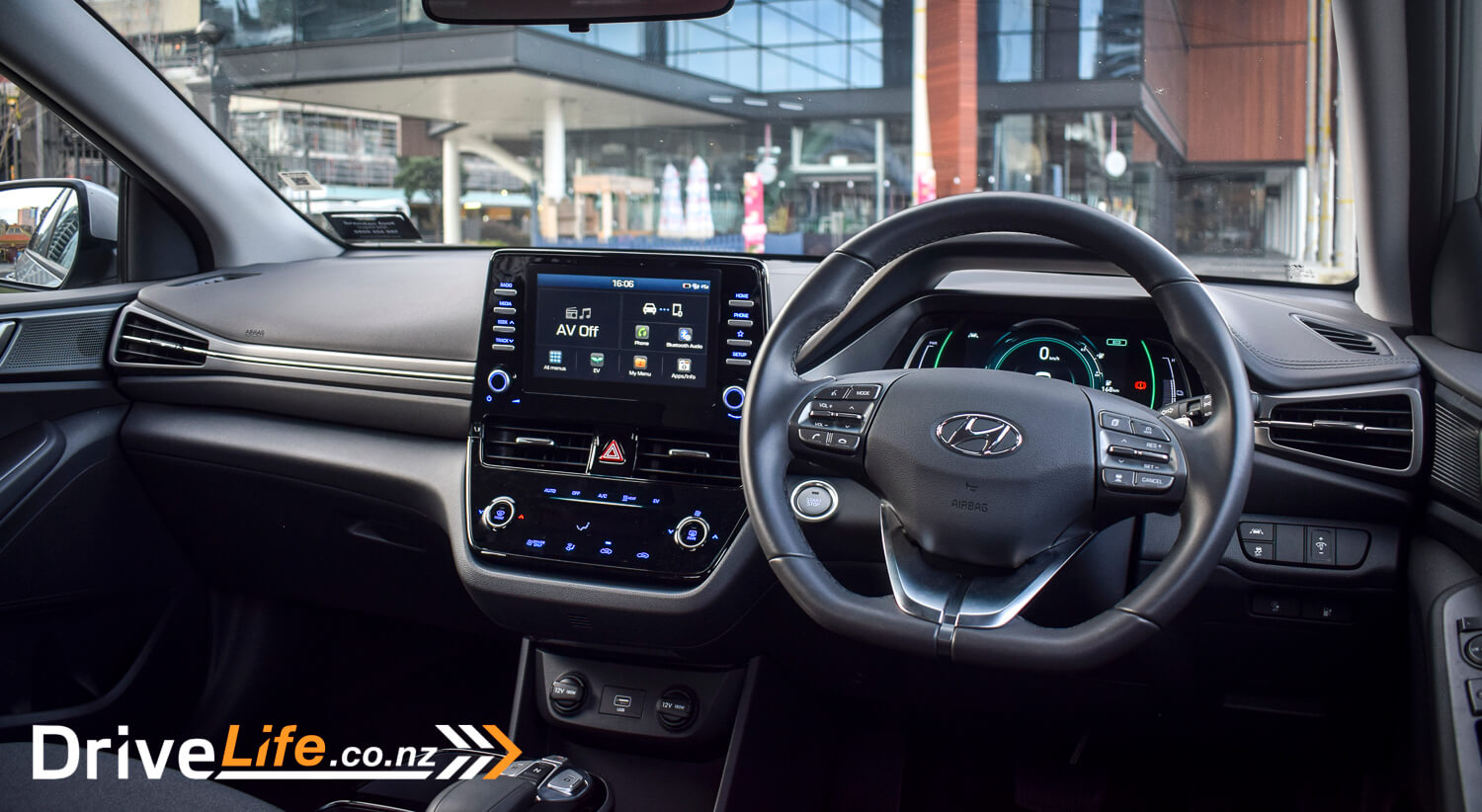
What Does The 2020 Hyundai Ioniq EV Series II Drive Like?
The first thing you are greeted with when starting Ioniq is a pleasant introductory soundtrack to notify you that your vehicle has started and is ready to drive. It’s an amusing little novelty, especially in the absence of a combustion engine firing into life. Hyundai has also incorporated a nice external reverse-gear chime to warn those behind it. It’s loud enough, yet not overly disturbing either. It’s certainly not a truck reverse signal.
On the subject of sounds, a prerequisite for all EV’s should be a good sound system, seeing as you’ll be hearing road noise a lot more. The stereo in our Ioniq was decent, even in our base-spec car which misses out on the Infinity 8-speaker system which the Elite has.
There are a few things you’ll quickly learn about driving an EV. One of those things is that although the fact that EV’s offer instant torque is well-publicised, nobody will mention how you begin to behave as a result.
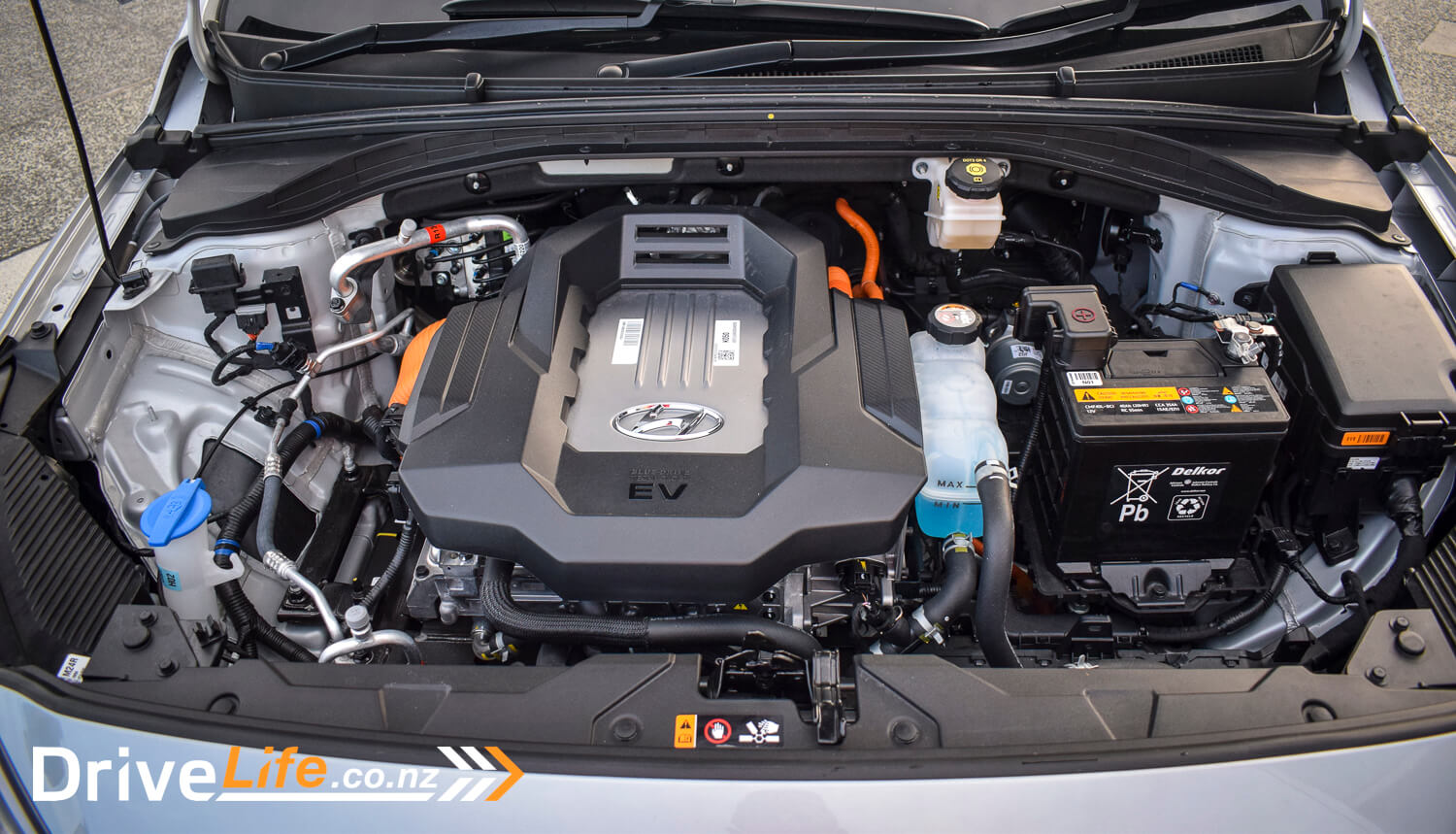
Switch the Ioniq into the selectable sport mode and immediately you’ve got the ultimate stop-light sprinter. The full and immediate torque will instantly push you ahead of traffic as the light turns green. A quick punch of the throttle and whoosh! There are few everyday vehicles that would keep-up with the Ioniq in a race to the 50kph speed limit.
Speaking of driving modes, the Ioniq EV offers four different drive modes, each making a considerable difference to the performance. These drive-modes are Normal, Sport, Eco and Eco +. Each mode setting has its own specific graphics on the instrument cluster. In Eco-mode, battery regeneration is set higher by default and throttle response noticeably drops. Range increases a fair amount as a result. Eco + takes steps further by adding a 90km/h speed-limit.
Conversely, engaging Sport mode sharpens the throttle and the car feels as if near all rolling resistance has been removed. The Ioniq EV isn’t necessarily a fast vehicle, nor is it quick on paper, but sport mode makes the car feel pretty darn brisk. As mentioned earlier, sport mode delivers the EV off-the-line acceleration which throws your head-back into the seat. It’s genuinely fun, and certainly will make many drivers grin. I recall having this head-back into the seat sensation for the first time in a C63 AMG. To have this feeling part-emulated in an economy hatchback is mind-boggling.
The Ioniq also offers the ability to adjust the level of regenerative braking yourself, regardless of drive mode. This is done using the paddle shifters, in place of where internal combustion cars would allow you to switch gears. Setting the regen up to its highest setting feels like the car had the brakes applied when lifting-off the accelerator. There were several instances where I used this to slow to a near-stop in traffic. On the opposite end, drop the regen into the lowest setting, and you’ll simply coast – for a while too. This is helped by the Ioniq’s ultra-low drag coefficient of 0.24Cd. Coasting in this manner is a bit surreal if you haven’t experienced it before, but cool nonetheless.
Overall, I genuinely appreciate how Hyundai has incorporated these paddles into the Ioniq, and it was easily one of the high points for me. I found myself using the regen to slow down before entering a corner, to hit an apex, then accelerating out of the corner in sport mode. I even managed to upset the traction control a few times doing this.
The combination of the instant torque and the regen paddles actually made the Ioniq EV, well… fun. Yep, I said the f-word, and I may be ostracised from my fellow petrol-heads for saying it, but allow me to explain. There’s many features being added to modern vehicles which serve to remove you from the driving experience. The Ioniq’s regen paddles and impactful driving modes are another way of reintroducing driver involvement, whether they’re trying to maximise range or just make the drive home a little bit more fun.
Sure, this is definitely a far cry away from having a fun manual transmission vehicle (I know this – I have an S2000), but for what this car is – a practical everyday hatchback – the experience is a lot more fun than you’d expect.
I do wish Hyundai had the drive-mode selector in a better location. The button is currently on the centre console and it doesn’t fall to hand very easily. It’s also something I did want to use often. I’d personally like to see it on the steering wheel, like Hyundai does with the I30N.
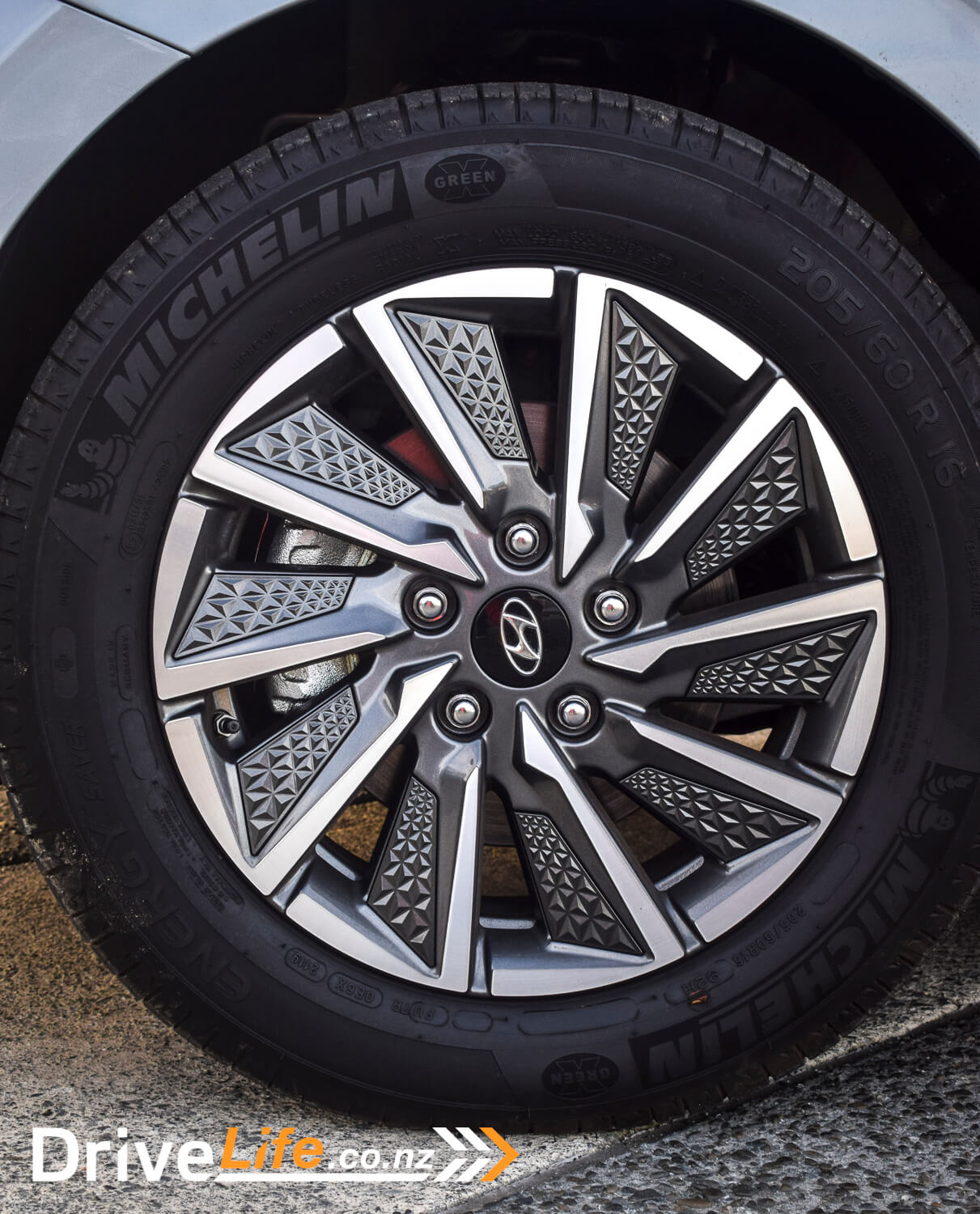
A pleasant surprise of the Ioniq was its driving refinement. The ride quality was decent and the handling was respectable despite a lack of steering feel. The Ioniq certainly made for a comfortable highway cruiser, and its road manners are even more impressive given that the EV gets a rear torsion beam as opposed to the multi-link set-ups of the Hybrid and PHEV. Hyundai’s suspension tweaks for the New Zealand and Australian markets have certainly paid off.
Another learning curve of living with an EV was recognising that internal features can impact your driving range. I did gasp when I saw the range estimate drop about 30 kilometres when I switched on the heater one morning. I should make a disclaimer – it’s only this bad if you turn it up high – though, on a couple of early mornings in the middle of winter, I did need to crank the heater.
Hyundai does have the common sense to integrate a “driver-only” climate control feature to moderate the energy consumption, which reduces this range trade-off. Also, Hyundai has programmed a feature to pre-heat the cabin and defog the windshield before driver-scheduled departure times while the car is plugged in. Smart thinking! I wish I employed the same level of smart-thinking by reading the manual before suffering through a few cold mornings with the heater off. You know it’s cold when you can see your own breath on the inside of the car!
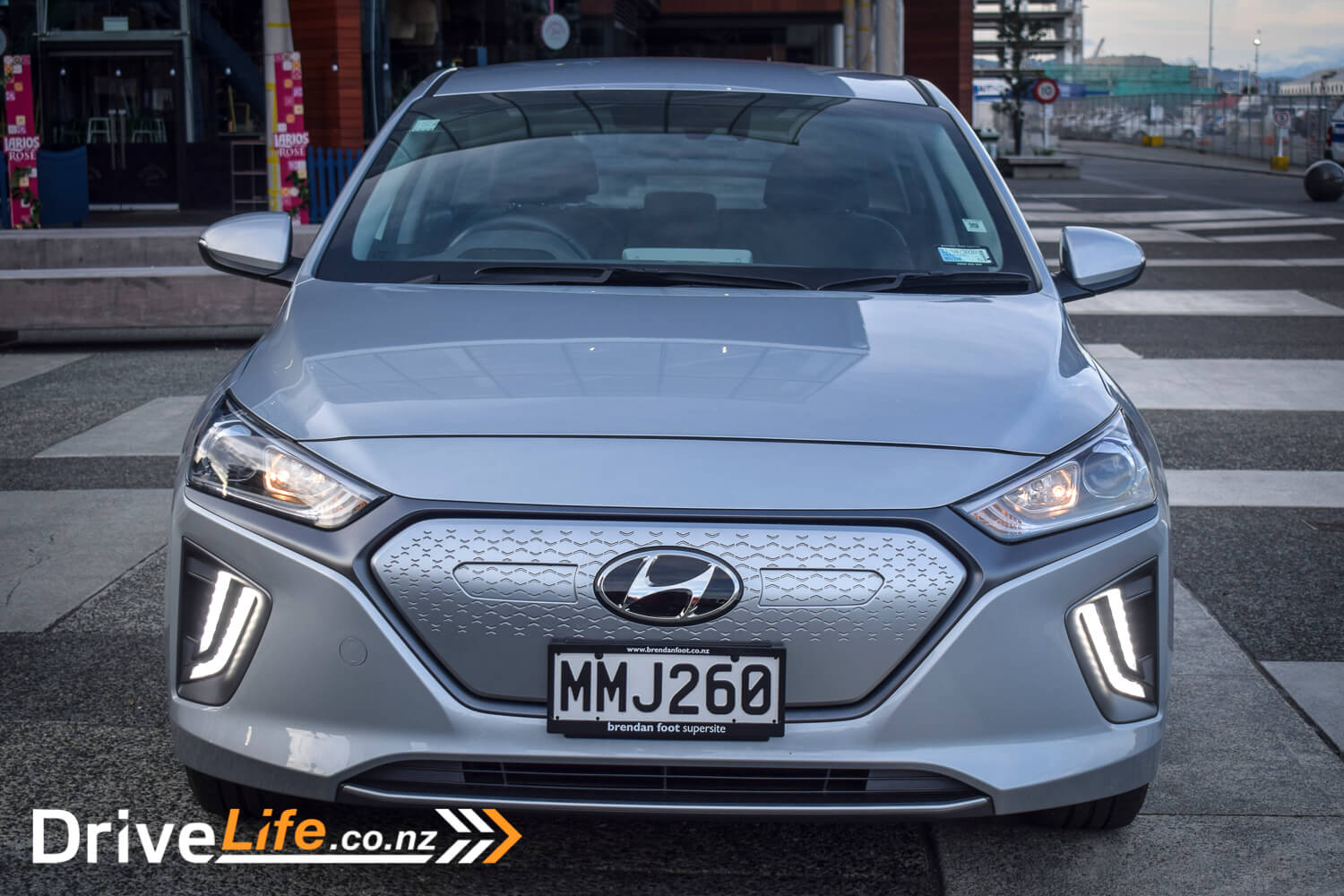
As for driver technology, Hyundai’s radar cruise system worked excellently and was easy to operate. The system operates down to a stop and can be reactivated with a tap of the pedal or a flick of the steering wheel control. Cruise control inputs were smooth and gradual, especially when reacting to traffic changing lanes on the motorway.
Hyundai’s Lane keep was quite firm when I first experienced it. Driving back home after picking up the car, I entered a merging lane a tad early and the car quickly snapped me back to where I was. At least I know the system is working! I should also remember to indicate next time to make sure it doesn’t happen! In practise, it’s perfectly liveable, but I prefer a gentler correction.
On the other hand, the Ioniq’s auto-high beams weren’t perfect. I found in some instances that it reacted quite late to other on-coming vehicles. I noted a few times where the system reacted late to some trucks on the motorway at night.
After a combination of driving mostly in Eco, some in Normal and a few quick squirts in Sport, I found myself getting around 14.1kWh per 100kms from the Ioniq. I was easily able to get this into the low 13s with some conservative driving, and also managed to get as low as 11.4kWh. Hyundai’s claimed figure of 13.8kWh is certainly realistic. This level is also very efficient energy consumption wise. For example, the Tesla Model 3 we tested claims 16kWh/100Kms, when in reality, it achieved around 22kWh/100Kms.
The marketing brochure will claim that the Ioniq EV has up to 311Km of range, while the owner’s manual says a charge will give you a realistic range of 270Kms. With smart use of regenerative braking, 311Km does seem achievable.
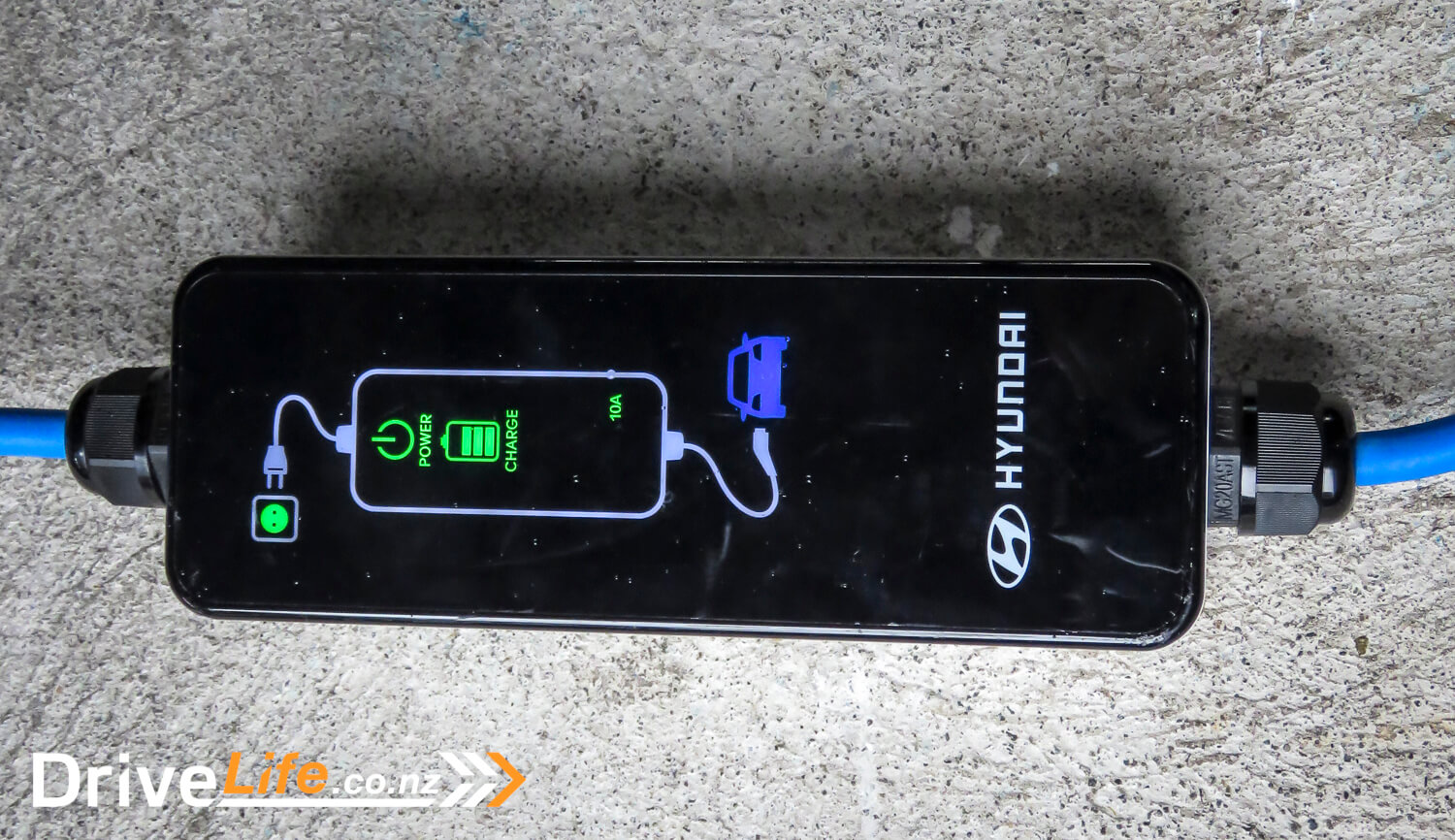
On the subject of charging, the Ioniq EV’s charge times vary quite considerably. Using one of the available fast chargers in town (DC chargers), can give you 80% of range in approximately 54 minutes. However, using one of the supplied at-home trickle chargers (AC charger – which plugs into the wall), a full 100% charge can take approximately 17 hours and 30 minutes! This can be sped up if you buy an at-home wall charger, which supports the AC charge by boosting the amps and can take charge times down to 6 hours for a 100% charge. These wall chargers require professional installation.
My experience of using one of Chargenet’s fast chargers in downtown Wellington for 47 minutes, or, for a 21.08 kWh charge, cost me $17.17c. This took the Ioniq from around 20% of its range up to near around 80%.
However, the key question is, did I experience any regular range anxiety with the Ioniq? Nope. Well, perhaps I did one or two times, but for the most part, the Ioniq’s range was more than adequate to complete daily life duties.
Also, my daily commute is longer than the average New Zealander, with my to-and-from work commute being around 52kms versus the average of 27kms. Plug the vehicle in overnight, and it’s enough to keep the battery topped up for the repeat journey. If you’re ever low, a quick 30 minutes on a fast charger was more than enough to get home.
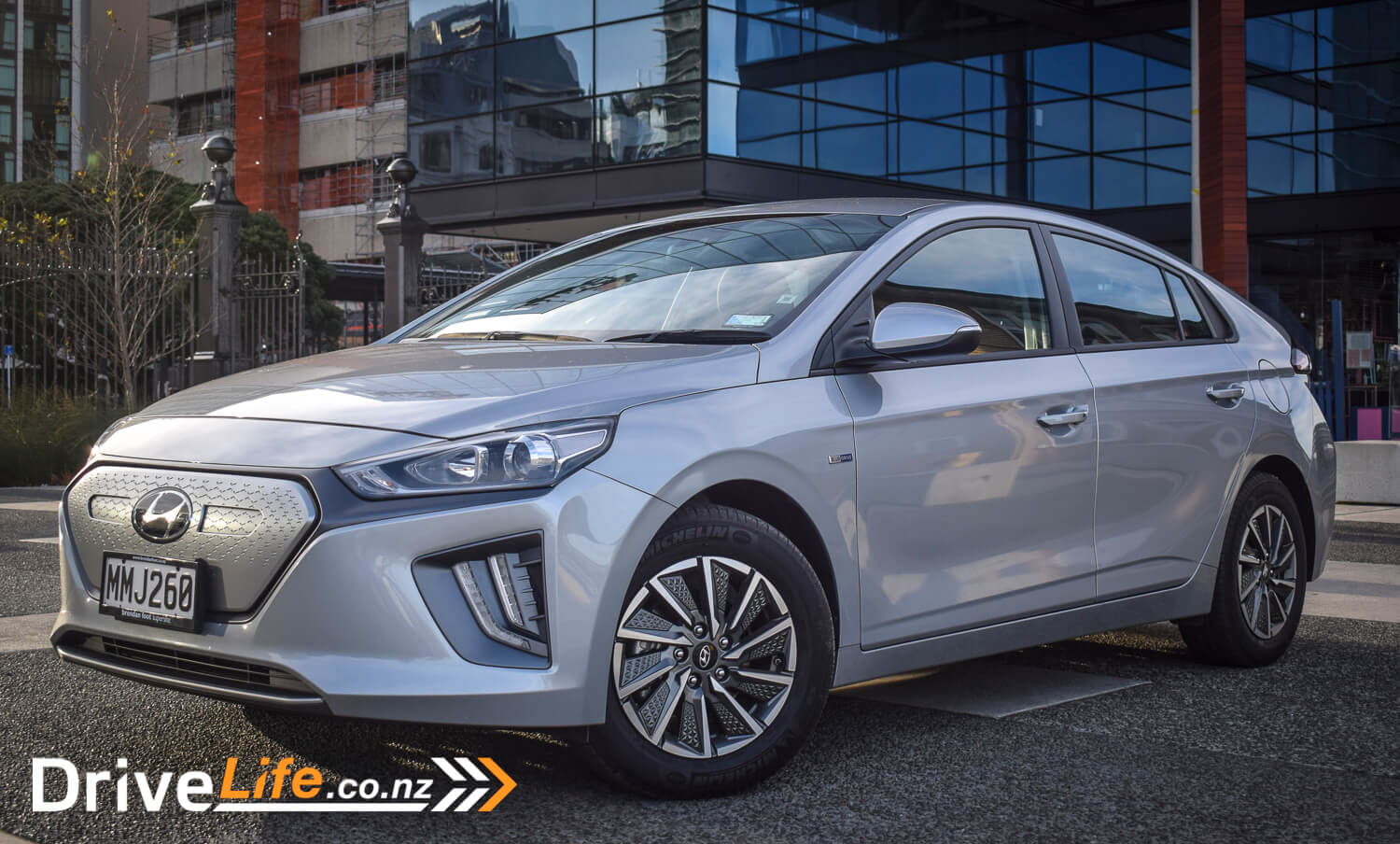
What’s The Competition For The 2020 Hyundai Ioniq EV Series II?
| Brand/Model | Engine | Power (kW)/ Torque (Nm) | Economy kWh/100km | Range | Seats | Boot Space, Litres | Price |
| Hyundai Kona EV | Single electric motor | 150/395 | 14.3 | 449 | 5 | 332 | $77,900 |
| BMW i3 i01 | Single electric motor | 125/250 | 13.1 | 185 – 359 | 4 | 365 | $77,200 |
| Tesla Model 3 Standard Range Plus | Single electric motor | 211/416 | 16 | 406 | 5 | 542 | $75,900 |
| Kia Niro | Single electric motor | 150/395 | 17.1 | 375 | 5 | 451 | $69,990 |
| Renault Zoe | Single electric motor | 100/245 | 16.5 | 315 | 5 | 338 | $68,990 |
| VW Golf E | Single electric motor | 100/290 | 16.8 | 190 | 5 | 341 | $68,490 |
| Hyundai Ioniq EV | Single electric motor | 100/295 | 13.8 | 311 | 5 | 350 | $65,990 |
What’s The Pros And Cons For The 2020 Hyundai Ioniq EV Series II?
PROS
- Decent range
- Adjustable regenerative brakes and paddle control
- Driving and performance modes
- Ride quality
- Visibility
- Good stereo
- Spacious interior
- Good Radar Cruise system
- Great energy consumption levels
CONS
- Basic interior
- Poor drive-mode button location
- Delayed auto-high beams
- Awkward centre-console storage holes

2020 Hyundai Ioniq EV Series II – Specifications
| Vehicle Type | 5-door medium hatchback |
| Starting Price | $65,990 |
| Price as Tested | $65,990 |
| Engine | Permanent Magnet Synchronous Motor |
| Power, Torque (kW/Nm) | 100/295 |
| Transmission | Direct Drive Reduction Gear |
| Spare Wheel | Pump only |
| Kerb Weight, Kg | 1,475 |
| Length x Width x Height (mm) | 4470 x 1820 x 1460 |
| Cargo Capacity litres | 350/1410 |
| Battery Capacity (kWh) | 38.3 |
| Battery Type | Lithium-Ion Polymer (Liquid-cooled) |
| Economy kWh/100km | Advertised Spec – 13.8 Real World Test – 14.1 |
| Towing Capacity Kg, unbraked/braked | N/A |
| Turning circle, metres | 10.6 Small: 6-10m / Medium 10-12m / Large 12m+ |
| Warranty | 10 year / 200,000 km anti perforation corrosion body warranty 10 year / 160,000 km high voltage battery warranty 3 year / 100,000 km mechanical warranty 3 year / 100,000 km roadside assistance package |
| ANCAP Safety Ratings | 5 Star |


